Get in touch
Sem fringilla ut morbi tincidunt augue interdum velit. Consequat interdum varius sit amet mattis vulputate enim nulla aliquet. Sed risus pretium quam vulputate dignissim suspendisse in.
Nautilus Marine Insurance Marina of the Year Awards
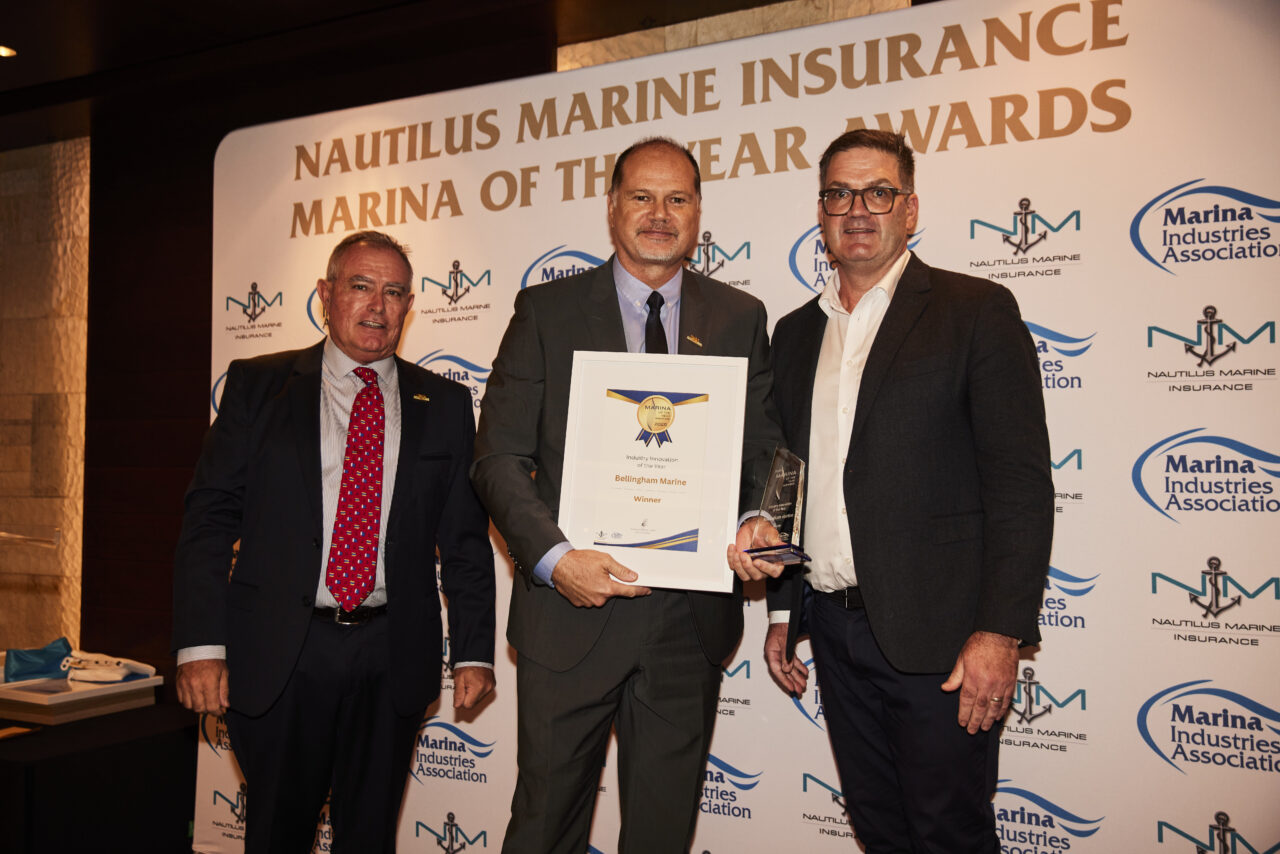
The best, brightest and proudest of the marina industry were recognised at the 2025 Nautilus Marine Insurance Marina of the Year Awards, held at Sydney’s picturesque Middle Harbour Skiff Club.
Opening the evening, Marina Industries Association (MIA) President and Master of Ceremonies, Andrew Chapman CMM remarked, “This is another incredibly successful celebration of our industry. The Awards attracted record entries across several categories, with over 110 guests and finalists gathering from across Australia, New Zealand, Thailand, the UAE and Singapore.”
Andrew Mulholland, Marketing Director / Commercial Partnerships Manager of event partner Nautilus Marine Insurance (NMI), echoed the sentiment, adding, “These Awards honour all entrants and finalists who consistently raise the bar and set new standards in our industry. While outstanding facilities are important, it’s the people who deliver the excellence we celebrate tonight.” Drawing a parallel with the Nautilus Marine Insurance values, Mullholland went on to say, “It’s about putting your customers at the core of everything you do and building trust through integrity and reliability.”
While the Awards have traditionally focused on facilities, 2025 saw the introduction of two new categories designed to spotlight and promote the achievements of individual contributions and rising talent. The inaugural Emerging Talent Award recognised future leaders under 35, with Jacob Morris, Director at Marine Structures, taking home the honour from a strong field. The new Industry Woman of the Year Award also made a strong debut, receiving a wave of impressive nominations. The winner, Stephanie Trounce, WHS Property and Compliance Manager at Gold Coast City Marina & Shipyard, was acknowledged for her deep expertise in safety systems and her leadership in maintaining high standards of property and compliance.
The flagship Marina of the Year categories were more competitive than ever. The recently redeveloped Jones Bay Superyacht Marina in Pyrmont, Sydney, emerged victorious as the Marina of the Year under 140 boats. It was a standout night for Gold Coast City Marina & Shipyard (GCCM), which claimed the Marina of the Year Award (over 140 boats), Boatyard of the Year (over 20 boats) and Dry Stack Facility Award. Celebrating 25 years of trailblazing excellence, GCCM has transformed former farming paddocks into a world-class marina and shipyard, playing a pivotal role in the development of the Coomera marine precinct.
Innovation was also in the spotlight this year, with Bellingham Marine taking home the Industry Innovation of the Year Award for its reimagined Unifloat system. The Royal Queensland Yacht Squadron (RQYS) once again claimed the coveted Club of the Year Award.
The competition in the Boatyard of the Year category for yards servicing under 20 boats was also strong, with White Bay 6 Marine Park taking the win. Industry veteran Lorraine Yates CMP reflected on the honour, “We’re grateful for industry recognition through awards like these. We have a beautiful facility in a stunning location, and I’m privileged that the owners trust us to manage it every day.”
The full list of Award winners for are 2025:
- Best Commercial Marina (Over 140 Boats): Gold Coast City Marina & Shipyard (GCCM), QLD
- Best Commercial Marina (Under 140 Boats): Jones Bay Superyacht Marina, NSW
- Club of the Year: Royal Queensland Yacht Squadron, QLD
- International Marina of the Year: Dubai Harbour Marina, UAE
- Dry Stack Storage Facility of the Year: Gold Coast City Marina & Shipyard, QLD
- Best Boat Yard (Under 20 Boats): White Bay 6 Marine Park, NSW
- Best Boat Yard (Over 20 Boats): Gold Coast City Marina & Shipyard, QLD
- Emerging Talent of the Year: Jacob Morris, QLD
- Industry Women of the Year: Stephanie Trounce, QLD
- MIA Environmental Award: Royal Phuket Marina, Thailand
- Industry Innovation Award: Bellingham Marine Australia, QLD
- Hall of Fame International Marina: ONE°15 Marina Sentosa Cove, Singapore
- Hall of Fame Dry Stack Storage Facility: Sydney Harbour Boat Storage
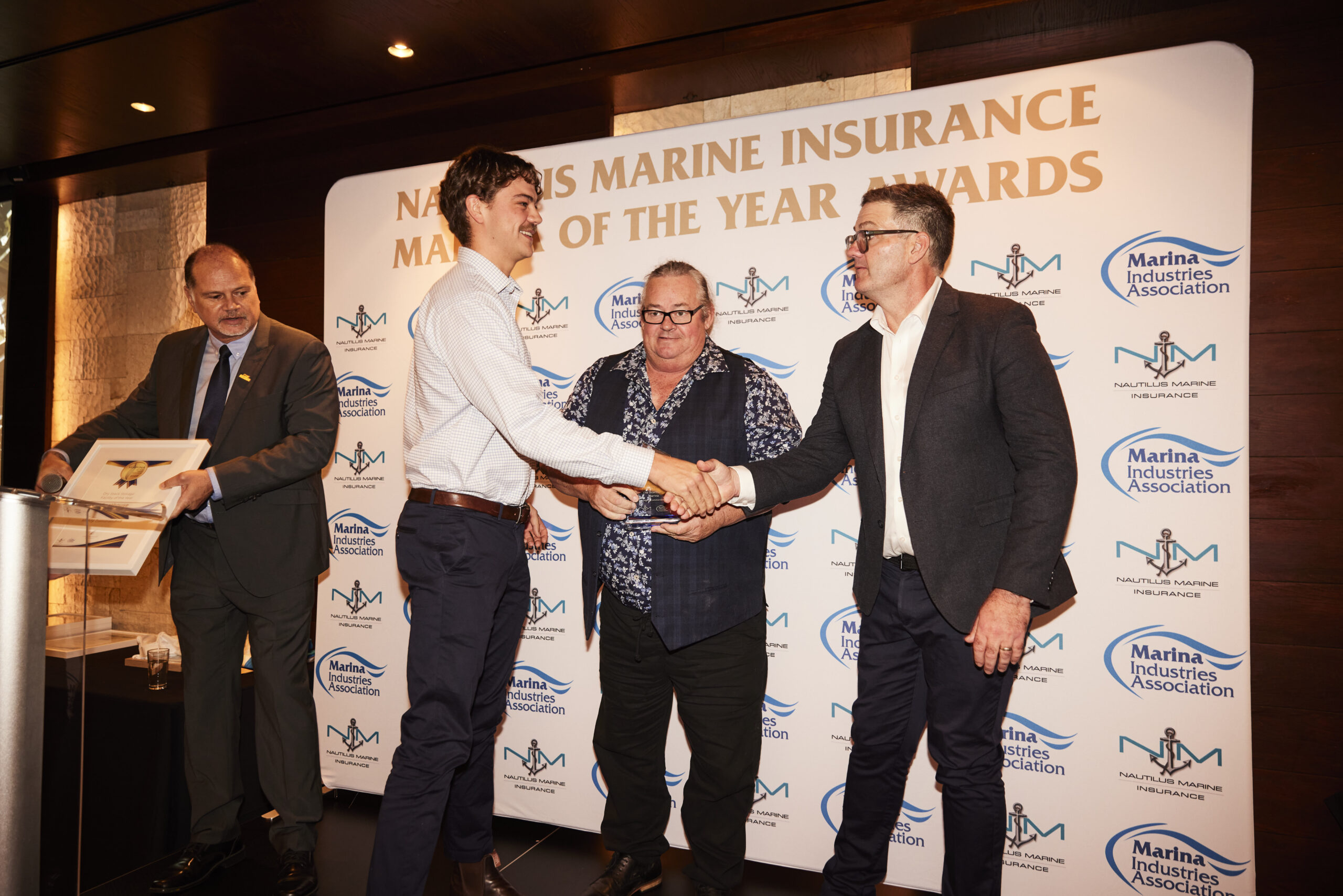

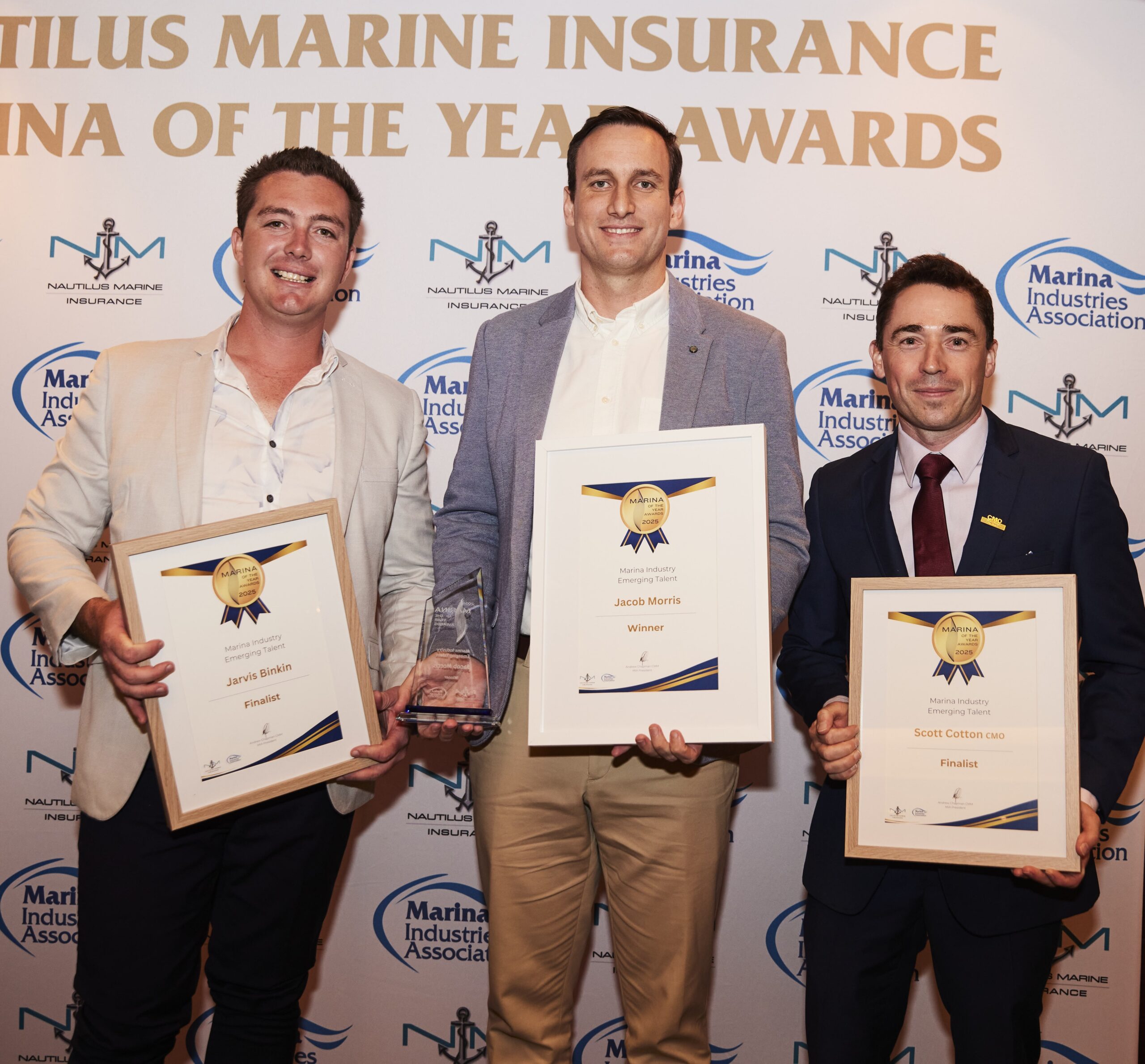
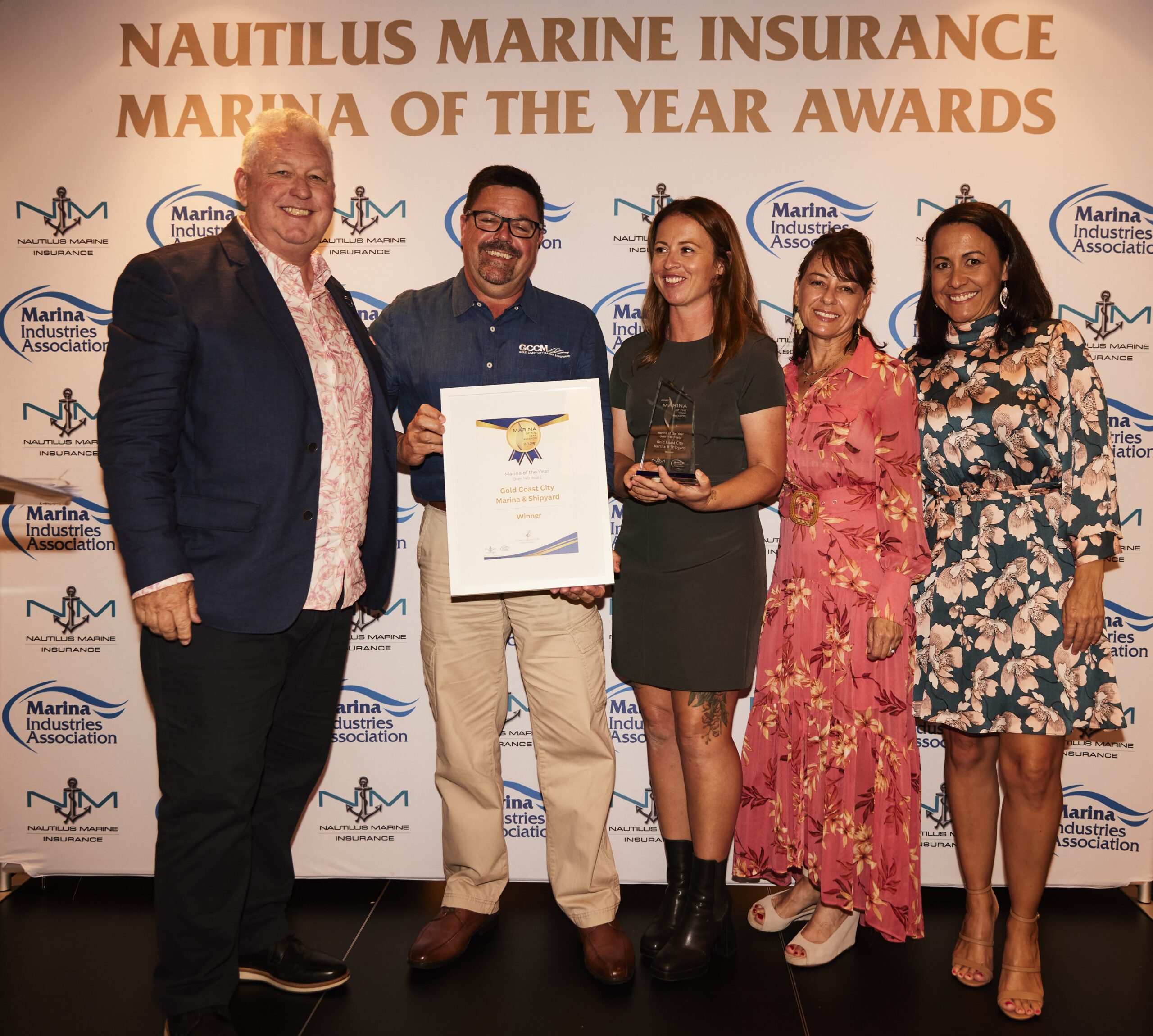
Nautilus Marine Insurance Marina of the Year Awards

The best, brightest and proudest of the marina industry were recognised at the 2025 Nautilus Marine Insurance Marina of the Year Awards, held at Sydney’s picturesque Middle Harbour Skiff Club.
Opening the evening, Marina Industries Association (MIA) President and Master of Ceremonies, Andrew Chapman CMM remarked, “This is another incredibly successful celebration of our industry. The Awards attracted record entries across several categories, with over 110 guests and finalists gathering from across Australia, New Zealand, Thailand, the UAE and Singapore.”
Andrew Mulholland, Marketing Director / Commercial Partnerships Manager of event partner Nautilus Marine Insurance (NMI), echoed the sentiment, adding, “These Awards honour all entrants and finalists who consistently raise the bar and set new standards in our industry. While outstanding facilities are important, it’s the people who deliver the excellence we celebrate tonight.” Drawing a parallel with the Nautilus Marine Insurance values, Mullholland went on to say, “It’s about putting your customers at the core of everything you do and building trust through integrity and reliability.”
While the Awards have traditionally focused on facilities, 2025 saw the introduction of two new categories designed to spotlight and promote the achievements of individual contributions and rising talent. The inaugural Emerging Talent Award recognised future leaders under 35, with Jacob Morris, Director at Marine Structures, taking home the honour from a strong field. The new Industry Woman of the Year Award also made a strong debut, receiving a wave of impressive nominations. The winner, Stephanie Trounce, WHS Property and Compliance Manager at Gold Coast City Marina & Shipyard, was acknowledged for her deep expertise in safety systems and her leadership in maintaining high standards of property and compliance.
The flagship Marina of the Year categories were more competitive than ever. The recently redeveloped Jones Bay Superyacht Marina in Pyrmont, Sydney, emerged victorious as the Marina of the Year under 140 boats. It was a standout night for Gold Coast City Marina & Shipyard (GCCM), which claimed the Marina of the Year Award (over 140 boats), Boatyard of the Year (over 20 boats) and Dry Stack Facility Award. Celebrating 25 years of trailblazing excellence, GCCM has transformed former farming paddocks into a world-class marina and shipyard, playing a pivotal role in the development of the Coomera marine precinct.
Innovation was also in the spotlight this year, with Bellingham Marine taking home the Industry Innovation of the Year Award for its reimagined Unifloat system. The Royal Queensland Yacht Squadron (RQYS) once again claimed the coveted Club of the Year Award.
The competition in the Boatyard of the Year category for yards servicing under 20 boats was also strong, with White Bay 6 Marine Park taking the win. Industry veteran Lorraine Yates CMP reflected on the honour, “We’re grateful for industry recognition through awards like these. We have a beautiful facility in a stunning location, and I’m privileged that the owners trust us to manage it every day.”
The full list of Award winners for are 2025:
- Best Commercial Marina (Over 140 Boats): Gold Coast City Marina & Shipyard (GCCM), QLD
- Best Commercial Marina (Under 140 Boats): Jones Bay Superyacht Marina, NSW
- Club of the Year: Royal Queensland Yacht Squadron, QLD
- International Marina of the Year: Dubai Harbour Marina, UAE
- Dry Stack Storage Facility of the Year: Gold Coast City Marina & Shipyard, QLD
- Best Boat Yard (Under 20 Boats): White Bay 6 Marine Park, NSW
- Best Boat Yard (Over 20 Boats): Gold Coast City Marina & Shipyard, QLD
- Emerging Talent of the Year: Jacob Morris, QLD
- Industry Women of the Year: Stephanie Trounce, QLD
- MIA Environmental Award: Royal Phuket Marina, Thailand
- Industry Innovation Award: Bellingham Marine Australia, QLD
- Hall of Fame International Marina: ONE°15 Marina Sentosa Cove, Singapore
- Hall of Fame Dry Stack Storage Facility: Sydney Harbour Boat Storage

Lyndon Turner

Glen Schembri

Trish Flaherty
Nautilus Marine Insurance Marina of the Year Awards

The NM Insurance Captain Awards have been created in recognition of broker excellence.
This year’s winners include PSC Aviation Marine and General Insurance, Network Insurance Group, Paterson & Co NZ Ltd, Risk Broking Pty Ltd, FINPAC Insurance Advisors, and Oceanic Marine Risks. We caught up with the winners to get their thoughts on receiving an NM Insurance Captain Award.

From left to right: Aaron Stephenson (PSC AMGI Insurance Brokers) and Glen Schembri (NM Insurance)
Aaron Stephenson, PSC AMGI Insurance Brokers (New South Wales)
Congratulations on receiving an NM Insurance Captain Award. How does it feel to be recognised with this award? I am humbled to be a recipient of the award and the recognition is reciprocal through the relationship with NM Insurance.
The NM Insurance Captain Awards concept recognise broker partners who consistently embody our NM Insurance values and traits. These include putting our customers first, building respect and trust through integrity and reliability, being results driven, working as one team and having a commitment to learning and growth. Do you see alignment between these values and your own company values and ethos? Absolutely, the qualities align with who we are. Applying these values consistently allows us opportunities to grow, especially with NM Insurance’s value and their growing product suite and offering.
At NM Insurance, we’re always striving to make our broker relationships true partnerships, based on trust, shared values and mutual success and growth. What are your thoughts on that? How would you sum up your experience of working with NM Insurance and the relationships you have built with our team? The relationship is seamless, efficient, and hassle-free. Dealing with NM gives us a lot of comfort in the relationship we have built over the years.
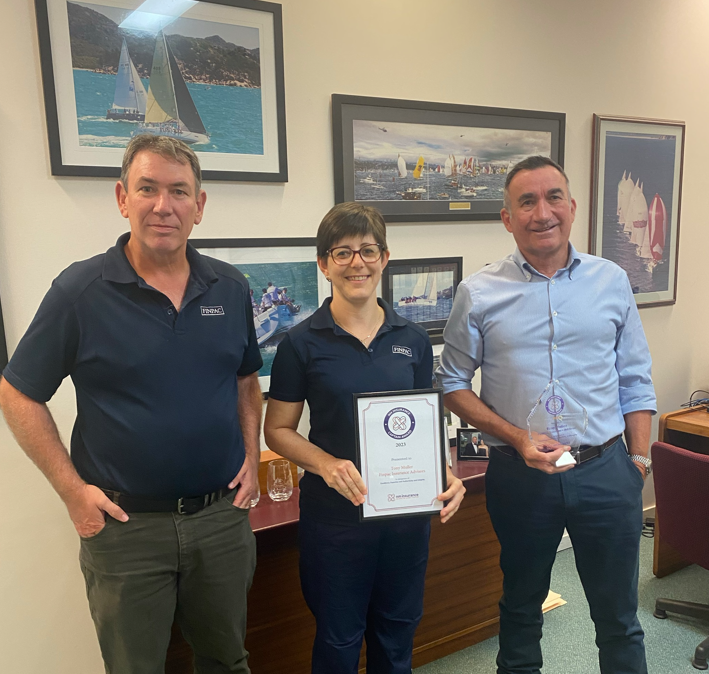
From left to right: Peter Honan, Alison Barton and Tony Muller (FINPAC Insurance Brokers)
Tony Muller, FINPAC Insurance Advisors (Queensland)
Congratulations on receiving an NM Insurance Captain Award. How does it feel to be recognised with this award? I’m very humbled to receive this award and I think it should also be recognised that I am supported by a very good team around me, both internally with people such as Alison Barton, and by NM Insurance staff members.
The NM Insurance Captain Awards concept recognise broker partners who consistently embody our NM Insurance values and traits. These include putting our customers first, building respect and trust through integrity and reliability, being results driven, working as one team and having a commitment to learning and growth. Do you see alignment between these values and your own company values and ethos? Yes I do, it’s important to have ease of communication and an alignment of goals and values.
At NM Insurance, we’re always striving to make our broker relationships true partnerships, based on trust, shared values and mutual success and growth. What are your thoughts on that? How would you sum up your experience of working with NM Insurance and the relationships you have built with our team? All we want is the best for our clients and to deal with someone you can trust. We’ve had a long-lasting relationship with NM Insurance and they have supported us and our clients over many years, hence the mutual success and growth.
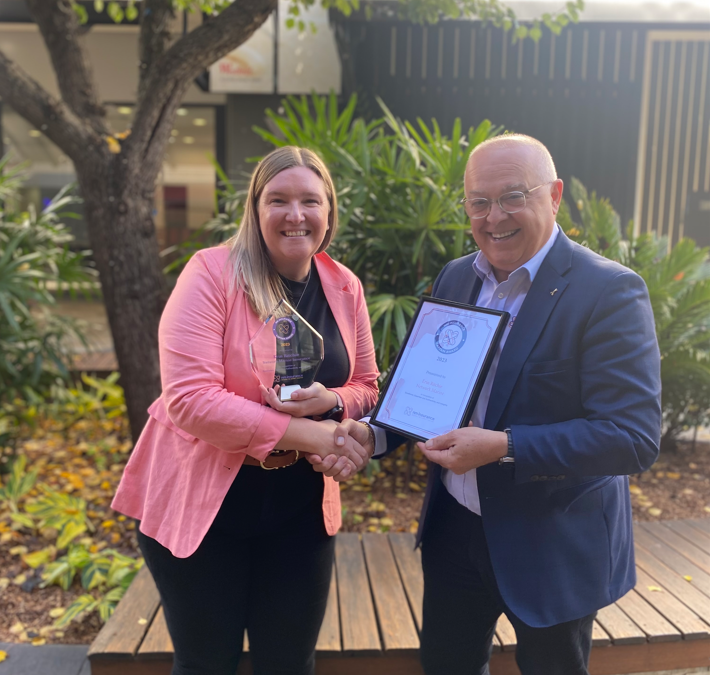
From left to right: Erin Ritchie (Network Insurance Group) and Louie Ralevski (NM Insurance)
Erin Ritchie, Network Insurance Group (New South Wales)
Congratulations on receiving an NM Insurance Captain Award. How does it feel to be recognised with this award? It is an incredible honour. It is not every day that you are recognised for the positive impacts you are making in business so to receive recognition like this is truly humbling.
The NM Insurance Captain Awards concept recognise broker partners who consistently embody our NM Insurance values and traits. These include putting our customers first, building respect and trust through integrity and reliability, being results driven, working as one team and having a commitment to learning and growth. Do you see alignment between these values and your own company values and ethos? Having worked with NM Insurance for over 10 years now, I feel that we have developed a solid, mutual respect of one another which has been driven by our commitment to our respective businesses to achieve and support one another’s goals.
At NM Insurance, we’re always striving to make our broker relationships true partnerships, based on trust, shared values and mutual success and growth. What are your thoughts on that? How would you sum up your experience of working with NM Insurance and the relationships you have built with our team? I enjoy picking up the phone and having a chat with Louie [Ralevski, NM Insurance North East Broker Distribution Manager] about his most recent food adventures or knowing that if I request a COC from Kim [Hendry, NM Insurance Underwriter Assistant] that I’ll have it the same day. Having that trust, enjoyment and confidence in an Insurer is so important as it reflects in our confidence, in how we can present to, and trust that we have sought the best policies for our clients’ needs! No matter how curly a risk may be, the NM Insurance team take the time to review the risk on its merits rather than simply placing it in the ‘too hard basket’. They look for ways to accommodate it and even if the answer is no, will always provide us with feedback around things our clients may be able to do to improve the risks.
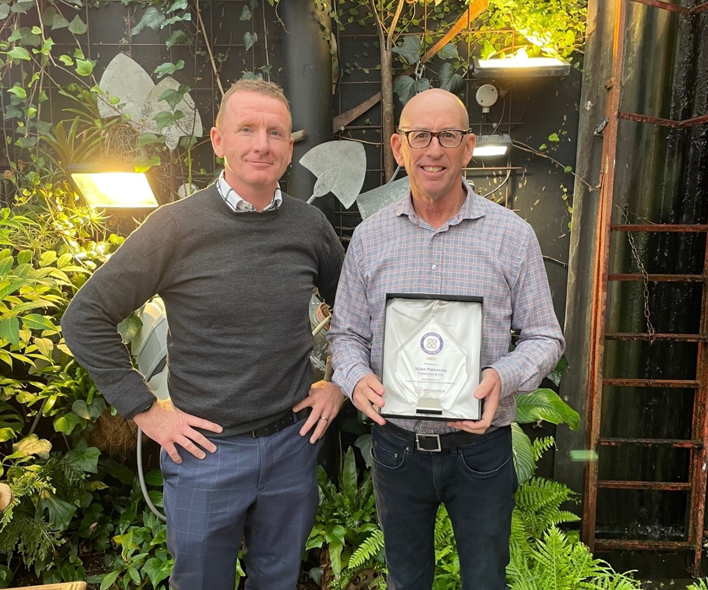
From left to right: Andrew McFetridge (NM Insurance NZ) and Mike Paterson (Paterson & Co NZ Ltd)
Mike Paterson, Paterson & Co NZ Ltd (Auckland)
Congratulations on receiving an NM Insurance Captain Award. How does it feel to be recognised with this award? It’s a huge recognition and I have not been recognised with an award like this before. We like to stay non-visible in market, stay out of the limelight and just do our thing as a specialist broker. But we are very proud and happy to be a recipient of such an award.
The NM Insurance Captain Awards concept recognise broker partners who consistently embody our NM Insurance values and traits. These include putting our customers first, building respect and trust through integrity and reliability, being results driven, working as one team and having a commitment to learning and growth. Do you see alignment between these values and your own company values and ethos? There is a strong synergy between our business and NM Insurance. Working with staff like Emma [Macadie, NM Insurance Marine Underwriter] and the team is important as it helps us provide our clients with a solution and makes the difficult, simple.
At NM Insurance, we’re always striving to make our broker relationships true partnerships, based on trust, shared values and mutual success and growth. What are your thoughts on that? How would you sum up your experience of working with NM Insurance and the relationships you have built with our team. This is a great example of a niche broker working with a specialist provider like NM, which helps us get the results and right outcomes for our clients.
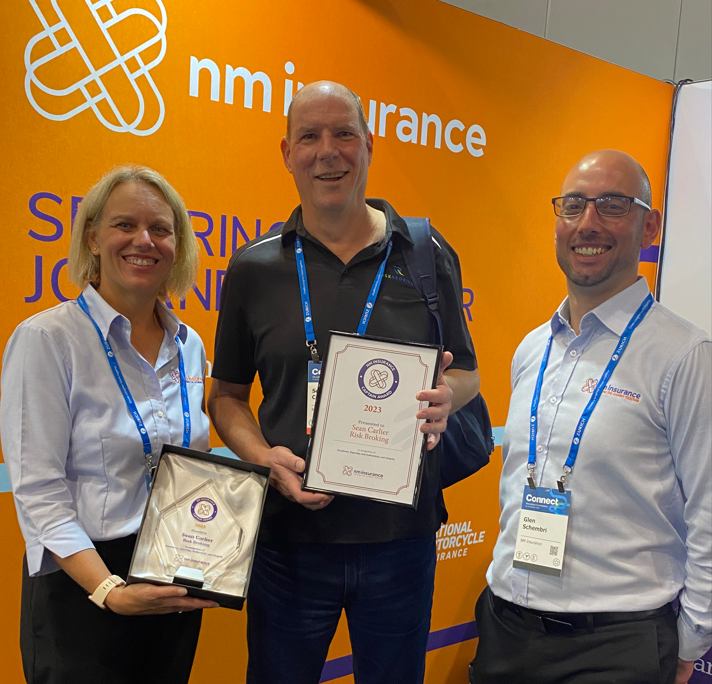
From left to right: Trish Flaherty (NM Insurance), Sean Carlier (Risk Broking Pty Ltd) and Glen Schembri (NM Insurance)
Sean Carlier, Risk Broking Pty Ltd (South Australia)
Congratulations on receiving an NM Insurance Captain Award. How does it feel to be recognised with this award? This award is confirmation we are doing the right thing and are focusing on our customers. It highlights the importance of working with our clients, combined with the support of our partners, to create solutions.
The NM Insurance Captain Awards concept recognise broker partners who consistently embody our NM Insurance values and traits. These include putting our customers first, building respect and trust through integrity and reliability, being results driven, working as one team and having a commitment to learning and growth. Do you see alignment between these values and your own company values and ethos? Customers are our number one priority and word of mouth is a powerful thing. It is very important to focus on these qualities to be successful.
At NM Insurance, we’re always striving to make our broker relationships true partnerships, based on trust, shared values and mutual success and growth. What are your thoughts on that? How would you sum up your experience of working with NM Insurance and the relationships you have built with our team? If you do the small things well, it will show in your results. Our relationship with NM Insurance is outstanding, even through tough times the support has always been there. NM Insurance has a great product, service, and support to match.
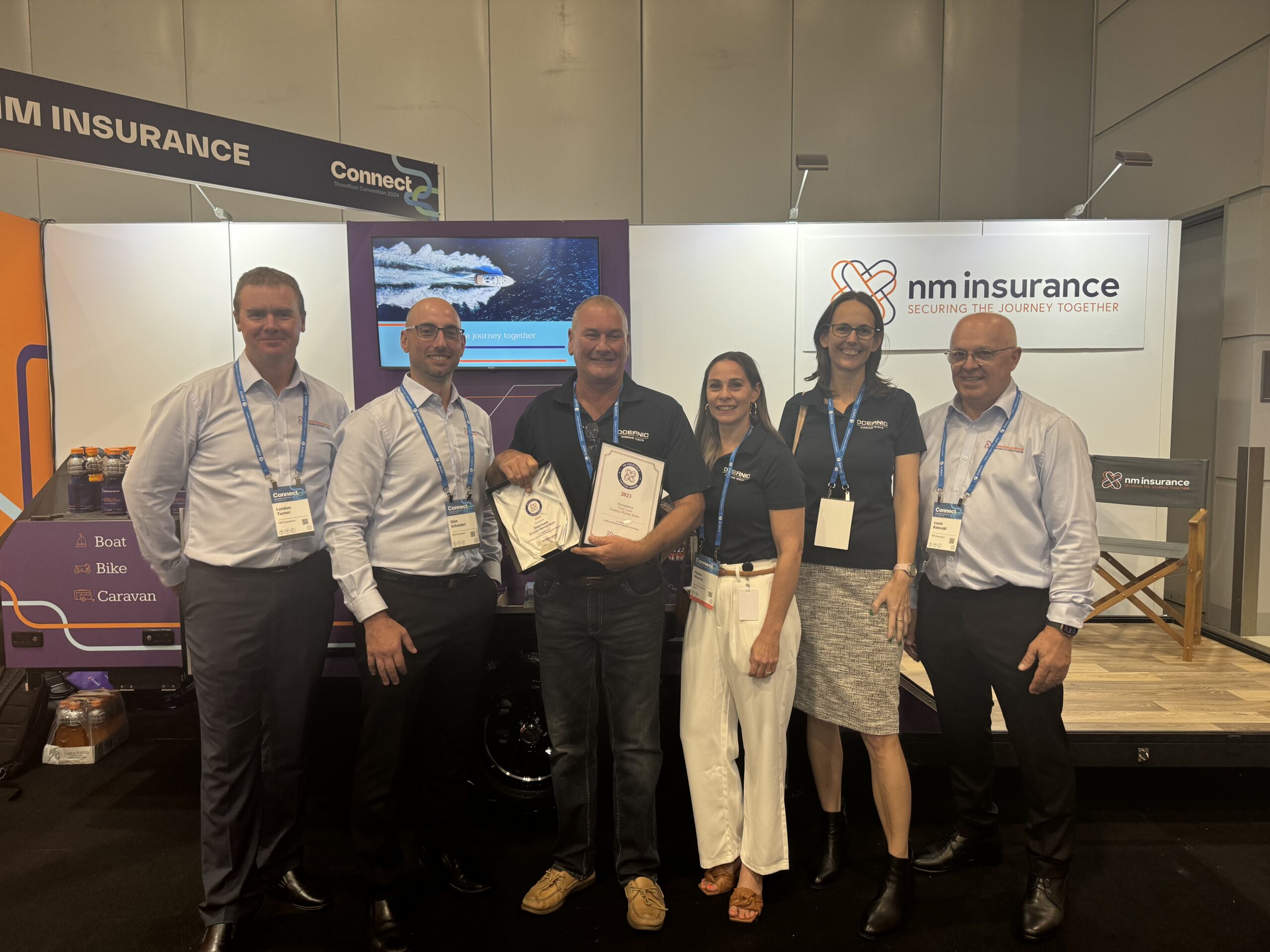
From left to right: Lyndon Turner (NM Insurance), Glen Schembri (NM Insurance), Troy Luck (Oceanic Marine Risks), Fiona Morris (Oceanic Marine Risks), Helen Hursey (Oceanic Marine Risks), Louie Ralevski (NM Insurance)
Troy Luck, Oceanic Marine Risks (Queensland)
Congratulations on receiving an NM Insurance Captain Award. How does it feel to be recognised with this award? It makes you feel special to receive recognition from providing the right outcome for customers through the relationship with NM Insurance.
The NM Insurance Captain Awards concept recognise broker partners who consistently embody our NM Insurance values and traits. These include putting our customers first, building respect and trust through integrity and reliability, being results driven, working as one team and having a commitment to learning and growth. Do you see alignment between these values and your own company values and ethos? Customers always come first, it is important to know your markets and get the right fit between customer and insurance provider.
At NM Insurance, we’re always striving to make our broker relationships true partnerships, based on trust, shared values and mutual success and growth. What are your thoughts on that? How would you sum up your experience of working with NM Insurance and the relationships you have built with our team? The relationship with NM Insurance is pretty seamless, and where issues may have arisen NM Insurance has been open and honest resulting in the best outcome for the customer.
Nautilus Marine Insurance Marina of the Year Awards

NM Insurance is pleased to announce the appointment of Andrew McFetridge as Executive Director of New Zealand. In this role, Andrew will be responsible for NM Insurance’s continued growth across the region, focussing energy on increased support to our customers, partners, product enhancement and service deliverables.
Andrew brings with him a wealth of experience and a proven track record in the insurance industry, including the agency landscape. Andrew is currently President of the New Zealand Underwriting Agencies Council (NZUAC) and will continue in this position. His strategic leadership and deep understanding of the New Zealand insurance market will be instrumental in driving NM Insurance’s continued growth and development in the region.
“We are delighted to welcome Andrew to the NM Insurance team,” says NM Insurance CEO Lyndon Turner. “His appointment marks a significant milestone in our commitment to strengthening our presence in New Zealand. Andrew’s leadership will be pivotal in further enhancing our relationships with insurance brokers and expanding our distribution networks.”
Andrew McFetridge expressed his enthusiasm for his new role, saying, “I am honoured to join NM Insurance at such an exciting time. I look forward to working closely with our talented team in New Zealand to build on the strong foundation established since 2010. Together, we will focus on innovation, customer service excellence, and strategic partnerships to solidify our position as experts in the commercial marine sector, and in consumer lines through both pleasurecraft and motorcycle insurance.”
Since September 2010, NM Insurance has specialized in providing comprehensive insurance solutions suited to the New Zealand market’s unique needs. Their marine, motorcycle, and commercial insurance offerings align with how New Zealanders, like Australians, choose to spend their leisure time. In his new role, Andrew will focus on growing and developing NM Insurance’s local New Zealand team, as well as expanding distribution networks to ensure NM Insurance remains at the forefront of the marine and motorcycle insurance sectors in New Zealand.
Nautilus Marine Insurance Marina of the Year Awards

The NM Insurance Captain Awards have been created in recognition of broker excellence.
This year’s winners include PSC Aviation Marine and General Insurance, Network Insurance Group, Paterson & Co NZ Ltd, Risk Broking Pty Ltd, FINPAC Insurance Advisors, and Oceanic Marine Risks. We caught up with the winners to get their thoughts on receiving an NM Insurance Captain Award.

Nautilus Marine Insurance Marina of the Year Awards

The best, brightest and proudest of the marina industry were recognised at the 2025 Nautilus Marine Insurance Marina of the Year Awards, held at Sydney’s picturesque Middle Harbour Skiff Club.
Opening the evening, Marina Industries Association (MIA) President and Master of Ceremonies, Andrew Chapman CMM remarked, “This is another incredibly successful celebration of our industry. The Awards attracted record entries across several categories, with over 110 guests and finalists gathering from across Australia, New Zealand, Thailand, the UAE and Singapore.”
Andrew Mulholland, Marketing Director / Commercial Partnerships Manager of event partner Nautilus Marine Insurance (NMI), echoed the sentiment, adding, “These Awards honour all entrants and finalists who consistently raise the bar and set new standards in our industry. While outstanding facilities are important, it’s the people who deliver the excellence we celebrate tonight.” Drawing a parallel with the Nautilus Marine Insurance values, Mullholland went on to say, “It’s about putting your customers at the core of everything you do and building trust through integrity and reliability.”
While the Awards have traditionally focused on facilities, 2025 saw the introduction of two new categories designed to spotlight and promote the achievements of individual contributions and rising talent. The inaugural Emerging Talent Award recognised future leaders under 35, with Jacob Morris, Director at Marine Structures, taking home the honour from a strong field. The new Industry Woman of the Year Award also made a strong debut, receiving a wave of impressive nominations. The winner, Stephanie Trounce, WHS Property and Compliance Manager at Gold Coast City Marina & Shipyard, was acknowledged for her deep expertise in safety systems and her leadership in maintaining high standards of property and compliance.
The flagship Marina of the Year categories were more competitive than ever. The recently redeveloped Jones Bay Superyacht Marina in Pyrmont, Sydney, emerged victorious as the Marina of the Year under 140 boats. It was a standout night for Gold Coast City Marina & Shipyard (GCCM), which claimed the Marina of the Year Award (over 140 boats), Boatyard of the Year (over 20 boats) and Dry Stack Facility Award. Celebrating 25 years of trailblazing excellence, GCCM has transformed former farming paddocks into a world-class marina and shipyard, playing a pivotal role in the development of the Coomera marine precinct.
Innovation was also in the spotlight this year, with Bellingham Marine taking home the Industry Innovation of the Year Award for its reimagined Unifloat system. The Royal Queensland Yacht Squadron (RQYS) once again claimed the coveted Club of the Year Award.
The competition in the Boatyard of the Year category for yards servicing under 20 boats was also strong, with White Bay 6 Marine Park taking the win. Industry veteran Lorraine Yates CMP reflected on the honour, “We’re grateful for industry recognition through awards like these. We have a beautiful facility in a stunning location, and I’m privileged that the owners trust us to manage it every day.”
The full list of Award winners for are 2025:
- Best Commercial Marina (Over 140 Boats): Gold Coast City Marina & Shipyard (GCCM), QLD
- Best Commercial Marina (Under 140 Boats): Jones Bay Superyacht Marina, NSW
- Club of the Year: Royal Queensland Yacht Squadron, QLD
- International Marina of the Year: Dubai Harbour Marina, UAE
- Dry Stack Storage Facility of the Year: Gold Coast City Marina & Shipyard, QLD
- Best Boat Yard (Under 20 Boats): White Bay 6 Marine Park, NSW
- Best Boat Yard (Over 20 Boats): Gold Coast City Marina & Shipyard, QLD
- Emerging Talent of the Year: Jacob Morris, QLD
- Industry Women of the Year: Stephanie Trounce, QLD
- MIA Environmental Award: Royal Phuket Marina, Thailand
- Industry Innovation Award: Bellingham Marine Australia, QLD
- Hall of Fame International Marina: ONE°15 Marina Sentosa Cove, Singapore
- Hall of Fame Dry Stack Storage Facility: Sydney Harbour Boat Storage


Andrew brings with him a wealth of experience and a proven track record in the insurance industry, including the agency landscape. Andrew is currently President of the New Zealand Underwriting Agencies Council (NZUAC) and will continue in this position. His strategic leadership and deep understanding of the New Zealand insurance market will be instrumental in driving NM Insurance’s continued growth and development in the region.
“We are delighted to welcome Andrew to the NM Insurance team,” says NM Insurance CEO Lyndon Turner. “His appointment marks a significant milestone in our commitment to strengthening our presence in New Zealand. Andrew’s leadership will be pivotal in further enhancing our relationships with insurance brokers and expanding our distribution networks.”
Andrew McFetridge expressed his enthusiasm for his new role, saying, “I am honoured to join NM Insurance at such an exciting time. I look forward to working closely with our talented team in New Zealand to build on the strong foundation established since 2010. Together, we will focus on innovation, customer service excellence, and strategic partnerships to solidify our position as experts in the commercial marine sector, and in consumer lines through both pleasurecraft and motorcycle insurance.”
Since September 2010, NM Insurance has specialized in providing comprehensive insurance solutions suited to the New Zealand market’s unique needs. Their marine, motorcycle, and commercial insurance offerings align with how New Zealanders, like Australians, choose to spend their leisure time. In his new role, Andrew will focus on growing and developing NM Insurance’s local New Zealand team, as well as expanding distribution networks to ensure NM Insurance remains at the forefront of the marine and motorcycle insurance sectors in New Zealand.
Nautilus Marine Insurance Marina of the Year Awards

Andrew brings with him a wealth of experience and a proven track record in the insurance industry, including the agency landscape. Andrew is currently President of the New Zealand Underwriting Agencies Council (NZUAC) and will continue in this position. His strategic leadership and deep understanding of the New Zealand insurance market will be instrumental in driving NM Insurance’s continued growth and development in the region.
“We are delighted to welcome Andrew to the NM Insurance team,” says NM Insurance CEO Lyndon Turner. “His appointment marks a significant milestone in our commitment to strengthening our presence in New Zealand. Andrew’s leadership will be pivotal in further enhancing our relationships with insurance brokers and expanding our distribution networks.”
Andrew McFetridge expressed his enthusiasm for his new role, saying, “I am honoured to join NM Insurance at such an exciting time. I look forward to working closely with our talented team in New Zealand to build on the strong foundation established since 2010. Together, we will focus on innovation, customer service excellence, and strategic partnerships to solidify our position as experts in the commercial marine sector, and in consumer lines through both pleasurecraft and motorcycle insurance.”
Since September 2010, NM Insurance has specialized in providing comprehensive insurance solutions suited to the New Zealand market’s unique needs. Their marine, motorcycle, and commercial insurance offerings align with how New Zealanders, like Australians, choose to spend their leisure time. In his new role, Andrew will focus on growing and developing NM Insurance’s local New Zealand team, as well as expanding distribution networks to ensure NM Insurance remains at the forefront of the marine and motorcycle insurance sectors in New Zealand.
Nautilus Marine Insurance Marina of the Year Awards

The NM Insurance Captain Awards have been created in recognition of broker excellence.
This year’s winners include PSC Aviation Marine and General Insurance, Network Insurance Group, Paterson & Co NZ Ltd, Risk Broking Pty Ltd, FINPAC Insurance Advisors, and Oceanic Marine Risks. We caught up with the winners to get their thoughts on receiving an NM Insurance Captain Award.

From left to right: Aaron Stephenson (PSC AMGI Insurance Brokers) and Glen Schembri (NM Insurance)
Aaron Stephenson, PSC AMGI Insurance Brokers (New South Wales)
Congratulations on receiving an NM Insurance Captain Award. How does it feel to be recognised with this award? I am humbled to be a recipient of the award and the recognition is reciprocal through the relationship with NM Insurance.
The NM Insurance Captain Awards concept recognise broker partners who consistently embody our NM Insurance values and traits. These include putting our customers first, building respect and trust through integrity and reliability, being results driven, working as one team and having a commitment to learning and growth. Do you see alignment between these values and your own company values and ethos? Absolutely, the qualities align with who we are. Applying these values consistently allows us opportunities to grow, especially with NM Insurance’s value and their growing product suite and offering.
At NM Insurance, we’re always striving to make our broker relationships true partnerships, based on trust, shared values and mutual success and growth. What are your thoughts on that? How would you sum up your experience of working with NM Insurance and the relationships you have built with our team? The relationship is seamless, efficient, and hassle-free. Dealing with NM gives us a lot of comfort in the relationship we have built over the years.

From left to right: Peter Honan, Alison Barton and Tony Muller (FINPAC Insurance Brokers)
Tony Muller, FINPAC Insurance Advisors (Queensland)
Congratulations on receiving an NM Insurance Captain Award. How does it feel to be recognised with this award? I’m very humbled to receive this award and I think it should also be recognised that I am supported by a very good team around me, both internally with people such as Alison Barton, and by NM Insurance staff members.
The NM Insurance Captain Awards concept recognise broker partners who consistently embody our NM Insurance values and traits. These include putting our customers first, building respect and trust through integrity and reliability, being results driven, working as one team and having a commitment to learning and growth. Do you see alignment between these values and your own company values and ethos? Yes I do, it’s important to have ease of communication and an alignment of goals and values.
At NM Insurance, we’re always striving to make our broker relationships true partnerships, based on trust, shared values and mutual success and growth. What are your thoughts on that? How would you sum up your experience of working with NM Insurance and the relationships you have built with our team? All we want is the best for our clients and to deal with someone you can trust. We’ve had a long-lasting relationship with NM Insurance and they have supported us and our clients over many years, hence the mutual success and growth.

From left to right: Erin Ritchie (Network Insurance Group) and Louie Ralevski (NM Insurance)
Erin Ritchie, Network Insurance Group (New South Wales)
Congratulations on receiving an NM Insurance Captain Award. How does it feel to be recognised with this award? It is an incredible honour. It is not every day that you are recognised for the positive impacts you are making in business so to receive recognition like this is truly humbling.
The NM Insurance Captain Awards concept recognise broker partners who consistently embody our NM Insurance values and traits. These include putting our customers first, building respect and trust through integrity and reliability, being results driven, working as one team and having a commitment to learning and growth. Do you see alignment between these values and your own company values and ethos? Having worked with NM Insurance for over 10 years now, I feel that we have developed a solid, mutual respect of one another which has been driven by our commitment to our respective businesses to achieve and support one another’s goals.
At NM Insurance, we’re always striving to make our broker relationships true partnerships, based on trust, shared values and mutual success and growth. What are your thoughts on that? How would you sum up your experience of working with NM Insurance and the relationships you have built with our team? I enjoy picking up the phone and having a chat with Louie [Ralevski, NM Insurance North East Broker Distribution Manager] about his most recent food adventures or knowing that if I request a COC from Kim [Hendry, NM Insurance Underwriter Assistant] that I’ll have it the same day. Having that trust, enjoyment and confidence in an Insurer is so important as it reflects in our confidence, in how we can present to, and trust that we have sought the best policies for our clients’ needs! No matter how curly a risk may be, the NM Insurance team take the time to review the risk on its merits rather than simply placing it in the ‘too hard basket’. They look for ways to accommodate it and even if the answer is no, will always provide us with feedback around things our clients may be able to do to improve the risks.

From left to right: Andrew McFetridge (NM Insurance NZ) and Mike Paterson (Paterson & Co NZ Ltd)
Mike Paterson, Paterson & Co NZ Ltd (Auckland)
Congratulations on receiving an NM Insurance Captain Award. How does it feel to be recognised with this award? It’s a huge recognition and I have not been recognised with an award like this before. We like to stay non-visible in market, stay out of the limelight and just do our thing as a specialist broker. But we are very proud and happy to be a recipient of such an award.
The NM Insurance Captain Awards concept recognise broker partners who consistently embody our NM Insurance values and traits. These include putting our customers first, building respect and trust through integrity and reliability, being results driven, working as one team and having a commitment to learning and growth. Do you see alignment between these values and your own company values and ethos? There is a strong synergy between our business and NM Insurance. Working with staff like Emma [Macadie, NM Insurance Marine Underwriter] and the team is important as it helps us provide our clients with a solution and makes the difficult, simple.
At NM Insurance, we’re always striving to make our broker relationships true partnerships, based on trust, shared values and mutual success and growth. What are your thoughts on that? How would you sum up your experience of working with NM Insurance and the relationships you have built with our team. This is a great example of a niche broker working with a specialist provider like NM, which helps us get the results and right outcomes for our clients.

From left to right: Trish Flaherty (NM Insurance), Sean Carlier (Risk Broking Pty Ltd) and Glen Schembri (NM Insurance)
Sean Carlier, Risk Broking Pty Ltd (South Australia)
Congratulations on receiving an NM Insurance Captain Award. How does it feel to be recognised with this award? This award is confirmation we are doing the right thing and are focusing on our customers. It highlights the importance of working with our clients, combined with the support of our partners, to create solutions.
The NM Insurance Captain Awards concept recognise broker partners who consistently embody our NM Insurance values and traits. These include putting our customers first, building respect and trust through integrity and reliability, being results driven, working as one team and having a commitment to learning and growth. Do you see alignment between these values and your own company values and ethos? Customers are our number one priority and word of mouth is a powerful thing. It is very important to focus on these qualities to be successful.
At NM Insurance, we’re always striving to make our broker relationships true partnerships, based on trust, shared values and mutual success and growth. What are your thoughts on that? How would you sum up your experience of working with NM Insurance and the relationships you have built with our team? If you do the small things well, it will show in your results. Our relationship with NM Insurance is outstanding, even through tough times the support has always been there. NM Insurance has a great product, service, and support to match.
Nautilus Marine Insurance Marina of the Year Awards

NM Insurance is proud to announce the launch of the inaugural NM Insurance Captain Awards. Judged by a panel of NM Insurance senior leadership team members, the awards have been created in recognition of insurance broker partners who embody excellence, expertise, authenticity, and integrity.
The winners of this year’s NM Insurance Captain Awards include Brookvale Insurance Brokers (NSW), Crombie Lockwood (New Zealand-wide), Helm Insurance Services (QLD), Pelagic Risk Services (NSW), and Safeguard Insurance Solutions (WA).

Andrew brings with him a wealth of experience and a proven track record in the insurance industry, including the agency landscape. Andrew is currently President of the New Zealand Underwriting Agencies Council (NZUAC) and will continue in this position. His strategic leadership and deep understanding of the New Zealand insurance market will be instrumental in driving NM Insurance’s continued growth and development in the region.
“We are delighted to welcome Andrew to the NM Insurance team,” says NM Insurance CEO Lyndon Turner. “His appointment marks a significant milestone in our commitment to strengthening our presence in New Zealand. Andrew’s leadership will be pivotal in further enhancing our relationships with insurance brokers and expanding our distribution networks.”
Andrew McFetridge expressed his enthusiasm for his new role, saying, “I am honoured to join NM Insurance at such an exciting time. I look forward to working closely with our talented team in New Zealand to build on the strong foundation established since 2010. Together, we will focus on innovation, customer service excellence, and strategic partnerships to solidify our position as experts in the commercial marine sector, and in consumer lines through both pleasurecraft and motorcycle insurance.”
Since September 2010, NM Insurance has specialized in providing comprehensive insurance solutions suited to the New Zealand market’s unique needs. Their marine, motorcycle, and commercial insurance offerings align with how New Zealanders, like Australians, choose to spend their leisure time. In his new role, Andrew will focus on growing and developing NM Insurance’s local New Zealand team, as well as expanding distribution networks to ensure NM Insurance remains at the forefront of the marine and motorcycle insurance sectors in New Zealand.
Nautilus Marine Insurance Marina of the Year Awards

NM Insurance is proud to announce the launch of the inaugural NM Insurance Captain Awards. Judged by a panel of NM Insurance senior leadership team members, the awards have been created in recognition of insurance broker partners who embody excellence, expertise, authenticity, and integrity.
The winners of this year’s NM Insurance Captain Awards include Brookvale Insurance Brokers (NSW), Crombie Lockwood (New Zealand-wide), Helm Insurance Services (QLD), Pelagic Risk Services (NSW), and Safeguard Insurance Solutions (WA).

Chris Baker
Head of Underwriting – Industry Lines
Andrew brings with him a wealth of experience and a proven track record in the insurance industry, including the agency landscape. Andrew is currently President of the New Zealand Underwriting Agencies Council (NZUAC) and will continue in this position. His strategic leadership and deep understanding of the New Zealand insurance market will be instrumental in driving NM Insurance’s continued growth and development in the region.
“We are delighted to welcome Andrew to the NM Insurance team,” says NM Insurance CEO Lyndon Turner. “His appointment marks a significant milestone in our commitment to strengthening our presence in New Zealand. Andrew’s leadership will be pivotal in further enhancing our relationships with insurance brokers and expanding our distribution networks.”
Andrew McFetridge expressed his enthusiasm for his new role, saying, “I am honoured to join NM Insurance at such an exciting time. I look forward to working closely with our talented team in New Zealand to build on the strong foundation established since 2010. Together, we will focus on innovation, customer service excellence, and strategic partnerships to solidify our position as experts in the commercial marine sector, and in consumer lines through both pleasurecraft and motorcycle insurance.”
Since September 2010, NM Insurance has specialized in providing comprehensive insurance solutions suited to the New Zealand market’s unique needs. Their marine, motorcycle, and commercial insurance offerings align with how New Zealanders, like Australians, choose to spend their leisure time. In his new role, Andrew will focus on growing and developing NM Insurance’s local New Zealand team, as well as expanding distribution networks to ensure NM Insurance remains at the forefront of the marine and motorcycle insurance sectors in New Zealand.
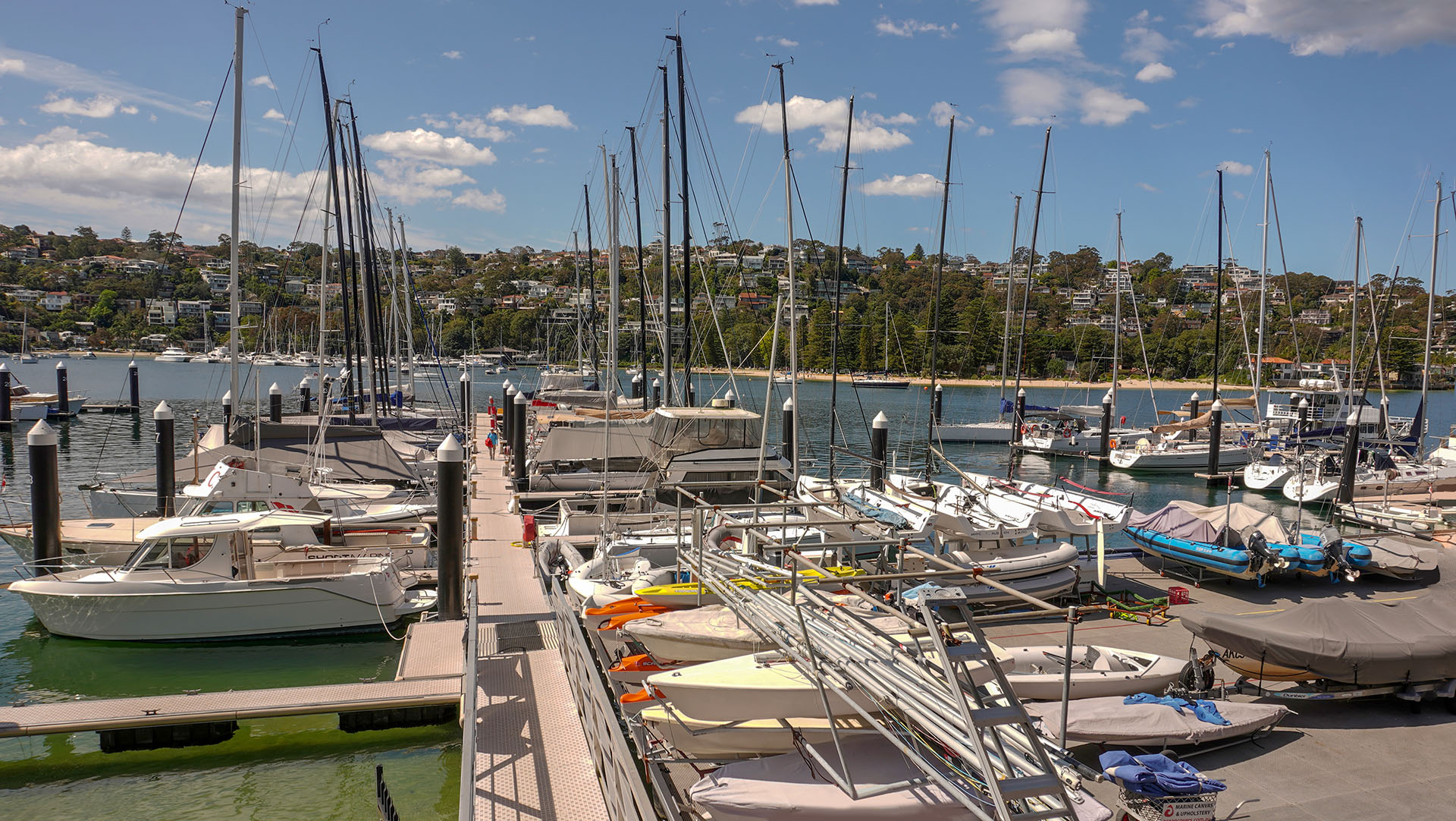
Engaging with an insurance broker
Nautilus Marine Insurance only transacts insurance business through insurance brokers. Insurance brokers operate independently of insurers, they work for you as your adviser. They should be impartial and should act in your best interests, at all times.
It is important to engage with an insurance broker who understands the marine industry. When speaking to your broker about information required by Insurers, it is essential to provide as much information as possible to help secure the best possible terms and avoid the Insurer making assumptions.
Highlight membership with the Marina Industries Association (MIA) and any accreditations that you have received such as Gold Anchor and Clean Marina. These programs demonstrate a good level of operational competence and risk management.
It is advantageous that your insurance solutions provider has an expert local claims team to support you should an incident occur.
Common risk exposures and claims
Damage to boats in your care: You have a duty of care, and a legal liability, to ensure that all customers and other third-party property is looked after while at your premises.
Fuelling activities: Pollution to waterways and other property damage can result from fuelling activities. Risk management practices in the Clean Marina Program can help you manage this risk.
Water damage to vessels: reminder notices to boat owners are very useful.
Incorrect boat storage on stands: poorly maintained stands, or stands with inadequate weight capacity, present a significant risk. Bad weather conditions also need to be considered as a factor for hard-stand facilities.
Spray painting: overspray from workshops could cause damage to surrounding property.
Contractor injuries or damage caused by contractors: injury claims can be very costly and take many years to be settled.
Customer accidents: slip and fall claims from customers are common, especially when getting on and off vessels. After hours risk management: procedures must be in place for out of hours risk management, especially in terms of weather events.
Weather damage to facilities: storm damage to floating assets such as wharves, piles and jetties are common risks.
Fire risks: we have seen claims from fires that start on a customer’s vessel and spread to the marina and other vessels at the marina. The marina operator can be held liable for damage to other customers vessels at the marina.
We hope you have found these insights useful. As you can see, most of these exposures and risk scenarios can be minimised by the implementation of documented risk management procedures.
Read the latest issue of the Marina Industries Association’s Waterline magazine here. To find out more information about the MIA visit www.marinas.net.au
Nautilus Marine Insurance Marina of the Year Awards

The best, brightest and proudest of the marina industry were recognised at the 2025 Nautilus Marine Insurance Marina of the Year Awards, held at Sydney’s picturesque Middle Harbour Skiff Club.
Opening the evening, Marina Industries Association (MIA) President and Master of Ceremonies, Andrew Chapman CMM remarked, “This is another incredibly successful celebration of our industry. The Awards attracted record entries across several categories, with over 110 guests and finalists gathering from across Australia, New Zealand, Thailand, the UAE and Singapore.”
Andrew Mulholland, Marketing Director / Commercial Partnerships Manager of event partner Nautilus Marine Insurance (NMI), echoed the sentiment, adding, “These Awards honour all entrants and finalists who consistently raise the bar and set new standards in our industry. While outstanding facilities are important, it’s the people who deliver the excellence we celebrate tonight.” Drawing a parallel with the Nautilus Marine Insurance values, Mullholland went on to say, “It’s about putting your customers at the core of everything you do and building trust through integrity and reliability.”
While the Awards have traditionally focused on facilities, 2025 saw the introduction of two new categories designed to spotlight and promote the achievements of individual contributions and rising talent. The inaugural Emerging Talent Award recognised future leaders under 35, with Jacob Morris, Director at Marine Structures, taking home the honour from a strong field. The new Industry Woman of the Year Award also made a strong debut, receiving a wave of impressive nominations. The winner, Stephanie Trounce, WHS Property and Compliance Manager at Gold Coast City Marina & Shipyard, was acknowledged for her deep expertise in safety systems and her leadership in maintaining high standards of property and compliance.
The flagship Marina of the Year categories were more competitive than ever. The recently redeveloped Jones Bay Superyacht Marina in Pyrmont, Sydney, emerged victorious as the Marina of the Year under 140 boats. It was a standout night for Gold Coast City Marina & Shipyard (GCCM), which claimed the Marina of the Year Award (over 140 boats), Boatyard of the Year (over 20 boats) and Dry Stack Facility Award. Celebrating 25 years of trailblazing excellence, GCCM has transformed former farming paddocks into a world-class marina and shipyard, playing a pivotal role in the development of the Coomera marine precinct.
Innovation was also in the spotlight this year, with Bellingham Marine taking home the Industry Innovation of the Year Award for its reimagined Unifloat system. The Royal Queensland Yacht Squadron (RQYS) once again claimed the coveted Club of the Year Award.
The competition in the Boatyard of the Year category for yards servicing under 20 boats was also strong, with White Bay 6 Marine Park taking the win. Industry veteran Lorraine Yates CMP reflected on the honour, “We’re grateful for industry recognition through awards like these. We have a beautiful facility in a stunning location, and I’m privileged that the owners trust us to manage it every day.”
The full list of Award winners for are 2025:
- Best Commercial Marina (Over 140 Boats): Gold Coast City Marina & Shipyard (GCCM), QLD
- Best Commercial Marina (Under 140 Boats): Jones Bay Superyacht Marina, NSW
- Club of the Year: Royal Queensland Yacht Squadron, QLD
- International Marina of the Year: Dubai Harbour Marina, UAE
- Dry Stack Storage Facility of the Year: Gold Coast City Marina & Shipyard, QLD
- Best Boat Yard (Under 20 Boats): White Bay 6 Marine Park, NSW
- Best Boat Yard (Over 20 Boats): Gold Coast City Marina & Shipyard, QLD
- Emerging Talent of the Year: Jacob Morris, QLD
- Industry Women of the Year: Stephanie Trounce, QLD
- MIA Environmental Award: Royal Phuket Marina, Thailand
- Industry Innovation Award: Bellingham Marine Australia, QLD
- Hall of Fame International Marina: ONE°15 Marina Sentosa Cove, Singapore
- Hall of Fame Dry Stack Storage Facility: Sydney Harbour Boat Storage

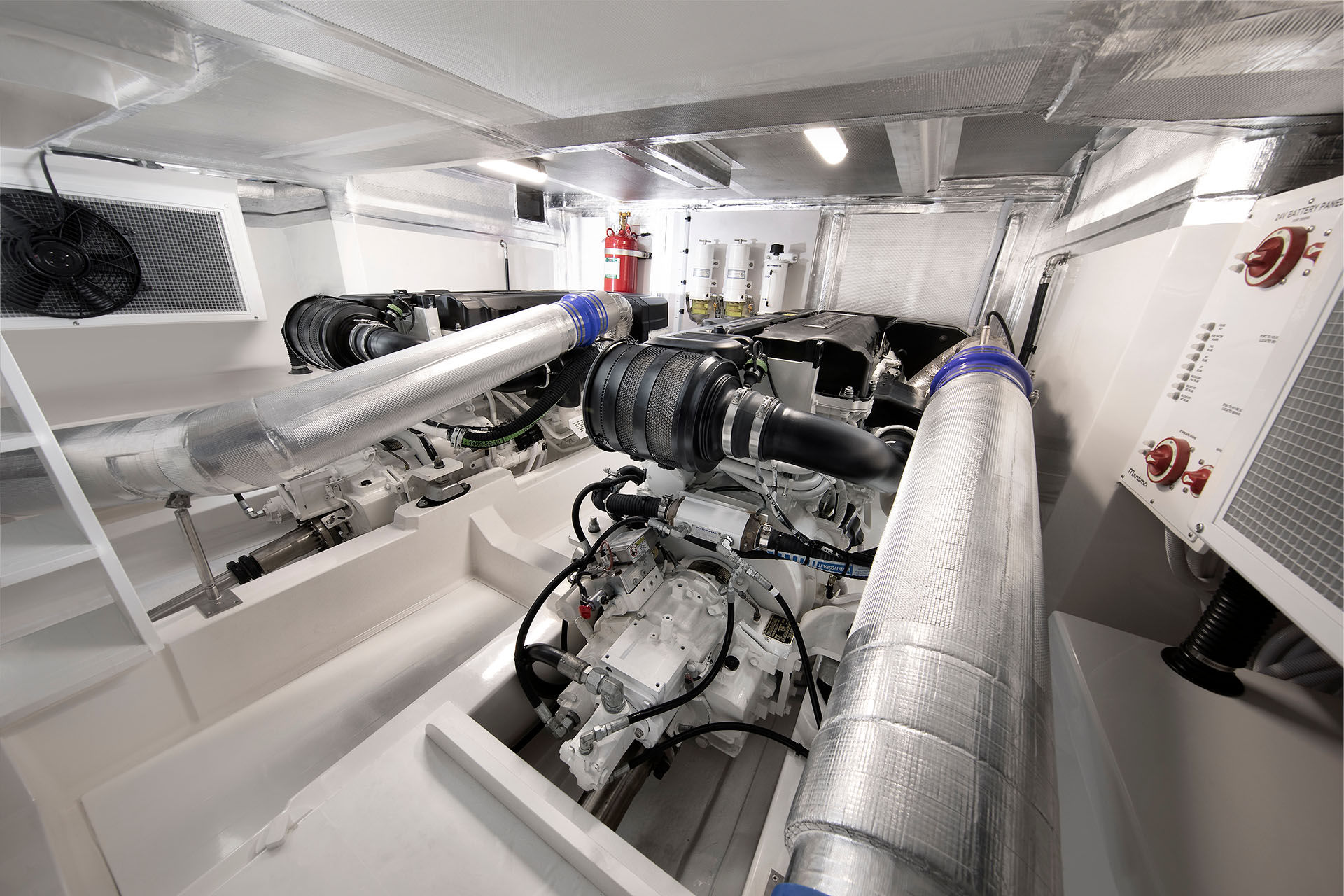
Andrew brings with him a wealth of experience and a proven track record in the insurance industry, including the agency landscape. Andrew is currently President of the New Zealand Underwriting Agencies Council (NZUAC) and will continue in this position. His strategic leadership and deep understanding of the New Zealand insurance market will be instrumental in driving NM Insurance’s continued growth and development in the region.
“We are delighted to welcome Andrew to the NM Insurance team,” says NM Insurance CEO Lyndon Turner. “His appointment marks a significant milestone in our commitment to strengthening our presence in New Zealand. Andrew’s leadership will be pivotal in further enhancing our relationships with insurance brokers and expanding our distribution networks.”
Andrew McFetridge expressed his enthusiasm for his new role, saying, “I am honoured to join NM Insurance at such an exciting time. I look forward to working closely with our talented team in New Zealand to build on the strong foundation established since 2010. Together, we will focus on innovation, customer service excellence, and strategic partnerships to solidify our position as experts in the commercial marine sector, and in consumer lines through both pleasurecraft and motorcycle insurance.”
Since September 2010, NM Insurance has specialized in providing comprehensive insurance solutions suited to the New Zealand market’s unique needs. Their marine, motorcycle, and commercial insurance offerings align with how New Zealanders, like Australians, choose to spend their leisure time. In his new role, Andrew will focus on growing and developing NM Insurance’s local New Zealand team, as well as expanding distribution networks to ensure NM Insurance remains at the forefront of the marine and motorcycle insurance sectors in New Zealand.

Nautilus Marine Insurance Marina of the Year Awards

NM Insurance is pleased to announce the appointment of Andrew McFetridge as Executive Director of New Zealand. In this role, Andrew will be responsible for NM Insurance’s continued growth across the region, focussing energy on increased support to our customers, partners, product enhancement and service deliverables.
Andrew brings with him a wealth of experience and a proven track record in the insurance industry, including the agency landscape. Andrew is currently President of the New Zealand Underwriting Agencies Council (NZUAC) and will continue in this position. His strategic leadership and deep understanding of the New Zealand insurance market will be instrumental in driving NM Insurance’s continued growth and development in the region.
“We are delighted to welcome Andrew to the NM Insurance team,” says NM Insurance CEO Lyndon Turner. “His appointment marks a significant milestone in our commitment to strengthening our presence in New Zealand. Andrew’s leadership will be pivotal in further enhancing our relationships with insurance brokers and expanding our distribution networks.”
Andrew McFetridge expressed his enthusiasm for his new role, saying, “I am honoured to join NM Insurance at such an exciting time. I look forward to working closely with our talented team in New Zealand to build on the strong foundation established since 2010. Together, we will focus on innovation, customer service excellence, and strategic partnerships to solidify our position as experts in the commercial marine sector, and in consumer lines through both pleasurecraft and motorcycle insurance.”
Since September 2010, NM Insurance has specialized in providing comprehensive insurance solutions suited to the New Zealand market’s unique needs. Their marine, motorcycle, and commercial insurance offerings align with how New Zealanders, like Australians, choose to spend their leisure time. In his new role, Andrew will focus on growing and developing NM Insurance’s local New Zealand team, as well as expanding distribution networks to ensure NM Insurance remains at the forefront of the marine and motorcycle insurance sectors in New Zealand.
Nautilus Marine Insurance Marina of the Year Awards

NM Insurance is pleased to announce the appointment of Andrew McFetridge as Executive Director of New Zealand. In this role, Andrew will be responsible for NM Insurance’s continued growth across the region, focussing energy on increased support to our customers, partners, product enhancement and service deliverables.
Andrew brings with him a wealth of experience and a proven track record in the insurance industry, including the agency landscape. Andrew is currently President of the New Zealand Underwriting Agencies Council (NZUAC) and will continue in this position. His strategic leadership and deep understanding of the New Zealand insurance market will be instrumental in driving NM Insurance’s continued growth and development in the region.
“We are delighted to welcome Andrew to the NM Insurance team,” says NM Insurance CEO Lyndon Turner. “His appointment marks a significant milestone in our commitment to strengthening our presence in New Zealand. Andrew’s leadership will be pivotal in further enhancing our relationships with insurance brokers and expanding our distribution networks.”
Andrew McFetridge expressed his enthusiasm for his new role, saying, “I am honoured to join NM Insurance at such an exciting time. I look forward to working closely with our talented team in New Zealand to build on the strong foundation established since 2010. Together, we will focus on innovation, customer service excellence, and strategic partnerships to solidify our position as experts in the commercial marine sector, and in consumer lines through both pleasurecraft and motorcycle insurance.”
Since September 2010, NM Insurance has specialized in providing comprehensive insurance solutions suited to the New Zealand market’s unique needs. Their marine, motorcycle, and commercial insurance offerings align with how New Zealanders, like Australians, choose to spend their leisure time. In his new role, Andrew will focus on growing and developing NM Insurance’s local New Zealand team, as well as expanding distribution networks to ensure NM Insurance remains at the forefront of the marine and motorcycle insurance sectors in New Zealand.
Nautilus Marine Insurance Marina of the Year Awards

NM Insurance is pleased to announce the appointment of Andrew McFetridge as Executive Director of New Zealand. In this role, Andrew will be responsible for NM Insurance’s continued growth across the region, focussing energy on increased support to our customers, partners, product enhancement and service deliverables.
Andrew brings with him a wealth of experience and a proven track record in the insurance industry, including the agency landscape. Andrew is currently President of the New Zealand Underwriting Agencies Council (NZUAC) and will continue in this position. His strategic leadership and deep understanding of the New Zealand insurance market will be instrumental in driving NM Insurance’s continued growth and development in the region.
“We are delighted to welcome Andrew to the NM Insurance team,” says NM Insurance CEO Lyndon Turner. “His appointment marks a significant milestone in our commitment to strengthening our presence in New Zealand. Andrew’s leadership will be pivotal in further enhancing our relationships with insurance brokers and expanding our distribution networks.”
Andrew McFetridge expressed his enthusiasm for his new role, saying, “I am honoured to join NM Insurance at such an exciting time. I look forward to working closely with our talented team in New Zealand to build on the strong foundation established since 2010. Together, we will focus on innovation, customer service excellence, and strategic partnerships to solidify our position as experts in the commercial marine sector, and in consumer lines through both pleasurecraft and motorcycle insurance.”
Since September 2010, NM Insurance has specialized in providing comprehensive insurance solutions suited to the New Zealand market’s unique needs. Their marine, motorcycle, and commercial insurance offerings align with how New Zealanders, like Australians, choose to spend their leisure time. In his new role, Andrew will focus on growing and developing NM Insurance’s local New Zealand team, as well as expanding distribution networks to ensure NM Insurance remains at the forefront of the marine and motorcycle insurance sectors in New Zealand.
Nautilus Marine Insurance Marina of the Year Awards

NM Insurance is pleased to announce the appointment of Andrew McFetridge as Executive Director of New Zealand. In this role, Andrew will be responsible for NM Insurance’s continued growth across the region, focussing energy on increased support to our customers, partners, product enhancement and service deliverables.
The best, brightest and proudest of the marina industry were recognised at the 2025 Nautilus Marine Insurance Marina of the Year Awards, held at Sydney’s picturesque Middle Harbour Skiff Club.
Opening the evening, Marina Industries Association (MIA) President and Master of Ceremonies, Andrew Chapman CMM remarked, “This is another incredibly successful celebration of our industry. The Awards attracted record entries across several categories, with over 110 guests and finalists gathering from across Australia, New Zealand, Thailand, the UAE and Singapore.”
Andrew Mulholland, Marketing Director / Commercial Partnerships Manager of event partner Nautilus Marine Insurance (NMI), echoed the sentiment, adding, “These Awards honour all entrants and finalists who consistently raise the bar and set new standards in our industry. While outstanding facilities are important, it’s the people who deliver the excellence we celebrate tonight.” Drawing a parallel with the Nautilus Marine Insurance values, Mullholland went on to say, “It’s about putting your customers at the core of everything you do and building trust through integrity and reliability.”
While the Awards have traditionally focused on facilities, 2025 saw the introduction of two new categories designed to spotlight and promote the achievements of individual contributions and rising talent. The inaugural Emerging Talent Award recognised future leaders under 35, with Jacob Morris, Director at Marine Structures, taking home the honour from a strong field. The new Industry Woman of the Year Award also made a strong debut, receiving a wave of impressive nominations. The winner, Stephanie Trounce, WHS Property and Compliance Manager at Gold Coast City Marina & Shipyard, was acknowledged for her deep expertise in safety systems and her leadership in maintaining high standards of property and compliance.
The flagship Marina of the Year categories were more competitive than ever. The recently redeveloped Jones Bay Superyacht Marina in Pyrmont, Sydney, emerged victorious as the Marina of the Year under 140 boats. It was a standout night for Gold Coast City Marina & Shipyard (GCCM), which claimed the Marina of the Year Award (over 140 boats), Boatyard of the Year (over 20 boats) and Dry Stack Facility Award. Celebrating 25 years of trailblazing excellence, GCCM has transformed former farming paddocks into a world-class marina and shipyard, playing a pivotal role in the development of the Coomera marine precinct.
Innovation was also in the spotlight this year, with Bellingham Marine taking home the Industry Innovation of the Year Award for its reimagined Unifloat system. The Royal Queensland Yacht Squadron (RQYS) once again claimed the coveted Club of the Year Award.
The competition in the Boatyard of the Year category for yards servicing under 20 boats was also strong, with White Bay 6 Marine Park taking the win. Industry veteran Lorraine Yates CMP reflected on the honour, “We’re grateful for industry recognition through awards like these. We have a beautiful facility in a stunning location, and I’m privileged that the owners trust us to manage it every day.”
The full list of Award winners for are 2025:
- Best Commercial Marina (Over 140 Boats): Gold Coast City Marina & Shipyard (GCCM), QLD
- Best Commercial Marina (Under 140 Boats): Jones Bay Superyacht Marina, NSW
- Club of the Year: Royal Queensland Yacht Squadron, QLD
- International Marina of the Year: Dubai Harbour Marina, UAE
- Dry Stack Storage Facility of the Year: Gold Coast City Marina & Shipyard, QLD
- Best Boat Yard (Under 20 Boats): White Bay 6 Marine Park, NSW
- Best Boat Yard (Over 20 Boats): Gold Coast City Marina & Shipyard, QLD
- Emerging Talent of the Year: Jacob Morris, QLD
- Industry Women of the Year: Stephanie Trounce, QLD
- MIA Environmental Award: Royal Phuket Marina, Thailand
- Industry Innovation Award: Bellingham Marine Australia, QLD
- Hall of Fame International Marina: ONE°15 Marina Sentosa Cove, Singapore
- Hall of Fame Dry Stack Storage Facility: Sydney Harbour Boat Storage

Chris Baker
Head of Underwriting – Industry Lines
Andrew brings with him a wealth of experience and a proven track record in the insurance industry, including the agency landscape. Andrew is currently President of the New Zealand Underwriting Agencies Council (NZUAC) and will continue in this position. His strategic leadership and deep understanding of the New Zealand insurance market will be instrumental in driving NM Insurance’s continued growth and development in the region.
“We are delighted to welcome Andrew to the NM Insurance team,” says NM Insurance CEO Lyndon Turner. “His appointment marks a significant milestone in our commitment to strengthening our presence in New Zealand. Andrew’s leadership will be pivotal in further enhancing our relationships with insurance brokers and expanding our distribution networks.”
Andrew McFetridge expressed his enthusiasm for his new role, saying, “I am honoured to join NM Insurance at such an exciting time. I look forward to working closely with our talented team in New Zealand to build on the strong foundation established since 2010. Together, we will focus on innovation, customer service excellence, and strategic partnerships to solidify our position as experts in the commercial marine sector, and in consumer lines through both pleasurecraft and motorcycle insurance.”
Since September 2010, NM Insurance has specialized in providing comprehensive insurance solutions suited to the New Zealand market’s unique needs. Their marine, motorcycle, and commercial insurance offerings align with how New Zealanders, like Australians, choose to spend their leisure time. In his new role, Andrew will focus on growing and developing NM Insurance’s local New Zealand team, as well as expanding distribution networks to ensure NM Insurance remains at the forefront of the marine and motorcycle insurance sectors in New Zealand.
Nautilus Marine Insurance Marina of the Year Awards

NM Insurance is pleased to announce the appointment of Andrew McFetridge as Executive Director of New Zealand. In this role, Andrew will be responsible for NM Insurance’s continued growth across the region, focussing energy on increased support to our customers, partners, product enhancement and service deliverables.
The best, brightest and proudest of the marina industry were recognised at the 2025 Nautilus Marine Insurance Marina of the Year Awards, held at Sydney’s picturesque Middle Harbour Skiff Club.
Opening the evening, Marina Industries Association (MIA) President and Master of Ceremonies, Andrew Chapman CMM remarked, “This is another incredibly successful celebration of our industry. The Awards attracted record entries across several categories, with over 110 guests and finalists gathering from across Australia, New Zealand, Thailand, the UAE and Singapore.”
Andrew Mulholland, Marketing Director / Commercial Partnerships Manager of event partner Nautilus Marine Insurance (NMI), echoed the sentiment, adding, “These Awards honour all entrants and finalists who consistently raise the bar and set new standards in our industry. While outstanding facilities are important, it’s the people who deliver the excellence we celebrate tonight.” Drawing a parallel with the Nautilus Marine Insurance values, Mullholland went on to say, “It’s about putting your customers at the core of everything you do and building trust through integrity and reliability.”
While the Awards have traditionally focused on facilities, 2025 saw the introduction of two new categories designed to spotlight and promote the achievements of individual contributions and rising talent. The inaugural Emerging Talent Award recognised future leaders under 35, with Jacob Morris, Director at Marine Structures, taking home the honour from a strong field. The new Industry Woman of the Year Award also made a strong debut, receiving a wave of impressive nominations. The winner, Stephanie Trounce, WHS Property and Compliance Manager at Gold Coast City Marina & Shipyard, was acknowledged for her deep expertise in safety systems and her leadership in maintaining high standards of property and compliance.
The flagship Marina of the Year categories were more competitive than ever. The recently redeveloped Jones Bay Superyacht Marina in Pyrmont, Sydney, emerged victorious as the Marina of the Year under 140 boats. It was a standout night for Gold Coast City Marina & Shipyard (GCCM), which claimed the Marina of the Year Award (over 140 boats), Boatyard of the Year (over 20 boats) and Dry Stack Facility Award. Celebrating 25 years of trailblazing excellence, GCCM has transformed former farming paddocks into a world-class marina and shipyard, playing a pivotal role in the development of the Coomera marine precinct.
Innovation was also in the spotlight this year, with Bellingham Marine taking home the Industry Innovation of the Year Award for its reimagined Unifloat system. The Royal Queensland Yacht Squadron (RQYS) once again claimed the coveted Club of the Year Award.
The competition in the Boatyard of the Year category for yards servicing under 20 boats was also strong, with White Bay 6 Marine Park taking the win. Industry veteran Lorraine Yates CMP reflected on the honour, “We’re grateful for industry recognition through awards like these. We have a beautiful facility in a stunning location, and I’m privileged that the owners trust us to manage it every day.”
The full list of Award winners for are 2025:
- Best Commercial Marina (Over 140 Boats): Gold Coast City Marina & Shipyard (GCCM), QLD
- Best Commercial Marina (Under 140 Boats): Jones Bay Superyacht Marina, NSW
- Club of the Year: Royal Queensland Yacht Squadron, QLD
- International Marina of the Year: Dubai Harbour Marina, UAE
- Dry Stack Storage Facility of the Year: Gold Coast City Marina & Shipyard, QLD
- Best Boat Yard (Under 20 Boats): White Bay 6 Marine Park, NSW
- Best Boat Yard (Over 20 Boats): Gold Coast City Marina & Shipyard, QLD
- Emerging Talent of the Year: Jacob Morris, QLD
- Industry Women of the Year: Stephanie Trounce, QLD
- MIA Environmental Award: Royal Phuket Marina, Thailand
- Industry Innovation Award: Bellingham Marine Australia, QLD
- Hall of Fame International Marina: ONE°15 Marina Sentosa Cove, Singapore
- Hall of Fame Dry Stack Storage Facility: Sydney Harbour Boat Storage

Chris Baker
Head of Underwriting – Industry Lines
Andrew brings with him a wealth of experience and a proven track record in the insurance industry, including the agency landscape. Andrew is currently President of the New Zealand Underwriting Agencies Council (NZUAC) and will continue in this position. His strategic leadership and deep understanding of the New Zealand insurance market will be instrumental in driving NM Insurance’s continued growth and development in the region.
“We are delighted to welcome Andrew to the NM Insurance team,” says NM Insurance CEO Lyndon Turner. “His appointment marks a significant milestone in our commitment to strengthening our presence in New Zealand. Andrew’s leadership will be pivotal in further enhancing our relationships with insurance brokers and expanding our distribution networks.”
Andrew McFetridge expressed his enthusiasm for his new role, saying, “I am honoured to join NM Insurance at such an exciting time. I look forward to working closely with our talented team in New Zealand to build on the strong foundation established since 2010. Together, we will focus on innovation, customer service excellence, and strategic partnerships to solidify our position as experts in the commercial marine sector, and in consumer lines through both pleasurecraft and motorcycle insurance.”
Since September 2010, NM Insurance has specialized in providing comprehensive insurance solutions suited to the New Zealand market’s unique needs. Their marine, motorcycle, and commercial insurance offerings align with how New Zealanders, like Australians, choose to spend their leisure time. In his new role, Andrew will focus on growing and developing NM Insurance’s local New Zealand team, as well as expanding distribution networks to ensure NM Insurance remains at the forefront of the marine and motorcycle insurance sectors in New Zealand.
Read Lyndon Turner’s full column in the latest issue of the Marina Industries Association’s Waterline magazine here. To find out more information about the MIA visit www.marinas.net.au
Nautilus Marine Insurance Marina of the Year Awards

The best, brightest and proudest of the marina industry were recognised at the 2025 Nautilus Marine Insurance Marina of the Year Awards, held at Sydney’s picturesque Middle Harbour Skiff Club.
Opening the evening, Marina Industries Association (MIA) President and Master of Ceremonies, Andrew Chapman CMM remarked, “This is another incredibly successful celebration of our industry. The Awards attracted record entries across several categories, with over 110 guests and finalists gathering from across Australia, New Zealand, Thailand, the UAE and Singapore.”
Andrew Mulholland, Marketing Director / Commercial Partnerships Manager of event partner Nautilus Marine Insurance (NMI), echoed the sentiment, adding, “These Awards honour all entrants and finalists who consistently raise the bar and set new standards in our industry. While outstanding facilities are important, it’s the people who deliver the excellence we celebrate tonight.” Drawing a parallel with the Nautilus Marine Insurance values, Mullholland went on to say, “It’s about putting your customers at the core of everything you do and building trust through integrity and reliability.”
While the Awards have traditionally focused on facilities, 2025 saw the introduction of two new categories designed to spotlight and promote the achievements of individual contributions and rising talent. The inaugural Emerging Talent Award recognised future leaders under 35, with Jacob Morris, Director at Marine Structures, taking home the honour from a strong field. The new Industry Woman of the Year Award also made a strong debut, receiving a wave of impressive nominations. The winner, Stephanie Trounce, WHS Property and Compliance Manager at Gold Coast City Marina & Shipyard, was acknowledged for her deep expertise in safety systems and her leadership in maintaining high standards of property and compliance.
The flagship Marina of the Year categories were more competitive than ever. The recently redeveloped Jones Bay Superyacht Marina in Pyrmont, Sydney, emerged victorious as the Marina of the Year under 140 boats. It was a standout night for Gold Coast City Marina & Shipyard (GCCM), which claimed the Marina of the Year Award (over 140 boats), Boatyard of the Year (over 20 boats) and Dry Stack Facility Award. Celebrating 25 years of trailblazing excellence, GCCM has transformed former farming paddocks into a world-class marina and shipyard, playing a pivotal role in the development of the Coomera marine precinct.
Innovation was also in the spotlight this year, with Bellingham Marine taking home the Industry Innovation of the Year Award for its reimagined Unifloat system. The Royal Queensland Yacht Squadron (RQYS) once again claimed the coveted Club of the Year Award.
The competition in the Boatyard of the Year category for yards servicing under 20 boats was also strong, with White Bay 6 Marine Park taking the win. Industry veteran Lorraine Yates CMP reflected on the honour, “We’re grateful for industry recognition through awards like these. We have a beautiful facility in a stunning location, and I’m privileged that the owners trust us to manage it every day.”
The full list of Award winners for are 2025:
- Best Commercial Marina (Over 140 Boats): Gold Coast City Marina & Shipyard (GCCM), QLD
- Best Commercial Marina (Under 140 Boats): Jones Bay Superyacht Marina, NSW
- Club of the Year: Royal Queensland Yacht Squadron, QLD
- International Marina of the Year: Dubai Harbour Marina, UAE
- Dry Stack Storage Facility of the Year: Gold Coast City Marina & Shipyard, QLD
- Best Boat Yard (Under 20 Boats): White Bay 6 Marine Park, NSW
- Best Boat Yard (Over 20 Boats): Gold Coast City Marina & Shipyard, QLD
- Emerging Talent of the Year: Jacob Morris, QLD
- Industry Women of the Year: Stephanie Trounce, QLD
- MIA Environmental Award: Royal Phuket Marina, Thailand
- Industry Innovation Award: Bellingham Marine Australia, QLD
- Hall of Fame International Marina: ONE°15 Marina Sentosa Cove, Singapore
- Hall of Fame Dry Stack Storage Facility: Sydney Harbour Boat Storage

Andrew brings with him a wealth of experience and a proven track record in the insurance industry, including the agency landscape. Andrew is currently President of the New Zealand Underwriting Agencies Council (NZUAC) and will continue in this position. His strategic leadership and deep understanding of the New Zealand insurance market will be instrumental in driving NM Insurance’s continued growth and development in the region.
“We are delighted to welcome Andrew to the NM Insurance team,” says NM Insurance CEO Lyndon Turner. “His appointment marks a significant milestone in our commitment to strengthening our presence in New Zealand. Andrew’s leadership will be pivotal in further enhancing our relationships with insurance brokers and expanding our distribution networks.”
Andrew McFetridge expressed his enthusiasm for his new role, saying, “I am honoured to join NM Insurance at such an exciting time. I look forward to working closely with our talented team in New Zealand to build on the strong foundation established since 2010. Together, we will focus on innovation, customer service excellence, and strategic partnerships to solidify our position as experts in the commercial marine sector, and in consumer lines through both pleasurecraft and motorcycle insurance.”
Since September 2010, NM Insurance has specialized in providing comprehensive insurance solutions suited to the New Zealand market’s unique needs. Their marine, motorcycle, and commercial insurance offerings align with how New Zealanders, like Australians, choose to spend their leisure time. In his new role, Andrew will focus on growing and developing NM Insurance’s local New Zealand team, as well as expanding distribution networks to ensure NM Insurance remains at the forefront of the marine and motorcycle insurance sectors in New Zealand.
Nautilus Marine Insurance Marina of the Year Awards

NM Insurance is pleased to announce the appointment of Andrew McFetridge as Executive Director of New Zealand. In this role, Andrew will be responsible for NM Insurance’s continued growth across the region, focussing energy on increased support to our customers, partners, product enhancement and service deliverables.
Andrew brings with him a wealth of experience and a proven track record in the insurance industry, including the agency landscape. Andrew is currently President of the New Zealand Underwriting Agencies Council (NZUAC) and will continue in this position. His strategic leadership and deep understanding of the New Zealand insurance market will be instrumental in driving NM Insurance’s continued growth and development in the region.
“We are delighted to welcome Andrew to the NM Insurance team,” says NM Insurance CEO Lyndon Turner. “His appointment marks a significant milestone in our commitment to strengthening our presence in New Zealand. Andrew’s leadership will be pivotal in further enhancing our relationships with insurance brokers and expanding our distribution networks.”
Andrew McFetridge expressed his enthusiasm for his new role, saying, “I am honoured to join NM Insurance at such an exciting time. I look forward to working closely with our talented team in New Zealand to build on the strong foundation established since 2010. Together, we will focus on innovation, customer service excellence, and strategic partnerships to solidify our position as experts in the commercial marine sector, and in consumer lines through both pleasurecraft and motorcycle insurance.”
Since September 2010, NM Insurance has specialized in providing comprehensive insurance solutions suited to the New Zealand market’s unique needs. Their marine, motorcycle, and commercial insurance offerings align with how New Zealanders, like Australians, choose to spend their leisure time. In his new role, Andrew will focus on growing and developing NM Insurance’s local New Zealand team, as well as expanding distribution networks to ensure NM Insurance remains at the forefront of the marine and motorcycle insurance sectors in New Zealand.
Nautilus Marine Insurance Marina of the Year Awards

NM Insurance is pleased to announce the appointment of Andrew McFetridge as Executive Director of New Zealand. In this role, Andrew will be responsible for NM Insurance’s continued growth across the region, focussing energy on increased support to our customers, partners, product enhancement and service deliverables.
The best, brightest and proudest of the marina industry were recognised at the 2025 Nautilus Marine Insurance Marina of the Year Awards, held at Sydney’s picturesque Middle Harbour Skiff Club.
Opening the evening, Marina Industries Association (MIA) President and Master of Ceremonies, Andrew Chapman CMM remarked, “This is another incredibly successful celebration of our industry. The Awards attracted record entries across several categories, with over 110 guests and finalists gathering from across Australia, New Zealand, Thailand, the UAE and Singapore.”
Andrew Mulholland, Marketing Director / Commercial Partnerships Manager of event partner Nautilus Marine Insurance (NMI), echoed the sentiment, adding, “These Awards honour all entrants and finalists who consistently raise the bar and set new standards in our industry. While outstanding facilities are important, it’s the people who deliver the excellence we celebrate tonight.” Drawing a parallel with the Nautilus Marine Insurance values, Mullholland went on to say, “It’s about putting your customers at the core of everything you do and building trust through integrity and reliability.”
While the Awards have traditionally focused on facilities, 2025 saw the introduction of two new categories designed to spotlight and promote the achievements of individual contributions and rising talent. The inaugural Emerging Talent Award recognised future leaders under 35, with Jacob Morris, Director at Marine Structures, taking home the honour from a strong field. The new Industry Woman of the Year Award also made a strong debut, receiving a wave of impressive nominations. The winner, Stephanie Trounce, WHS Property and Compliance Manager at Gold Coast City Marina & Shipyard, was acknowledged for her deep expertise in safety systems and her leadership in maintaining high standards of property and compliance.
The flagship Marina of the Year categories were more competitive than ever. The recently redeveloped Jones Bay Superyacht Marina in Pyrmont, Sydney, emerged victorious as the Marina of the Year under 140 boats. It was a standout night for Gold Coast City Marina & Shipyard (GCCM), which claimed the Marina of the Year Award (over 140 boats), Boatyard of the Year (over 20 boats) and Dry Stack Facility Award. Celebrating 25 years of trailblazing excellence, GCCM has transformed former farming paddocks into a world-class marina and shipyard, playing a pivotal role in the development of the Coomera marine precinct.
Innovation was also in the spotlight this year, with Bellingham Marine taking home the Industry Innovation of the Year Award for its reimagined Unifloat system. The Royal Queensland Yacht Squadron (RQYS) once again claimed the coveted Club of the Year Award.
The competition in the Boatyard of the Year category for yards servicing under 20 boats was also strong, with White Bay 6 Marine Park taking the win. Industry veteran Lorraine Yates CMP reflected on the honour, “We’re grateful for industry recognition through awards like these. We have a beautiful facility in a stunning location, and I’m privileged that the owners trust us to manage it every day.”
The full list of Award winners for are 2025:
- Best Commercial Marina (Over 140 Boats): Gold Coast City Marina & Shipyard (GCCM), QLD
- Best Commercial Marina (Under 140 Boats): Jones Bay Superyacht Marina, NSW
- Club of the Year: Royal Queensland Yacht Squadron, QLD
- International Marina of the Year: Dubai Harbour Marina, UAE
- Dry Stack Storage Facility of the Year: Gold Coast City Marina & Shipyard, QLD
- Best Boat Yard (Under 20 Boats): White Bay 6 Marine Park, NSW
- Best Boat Yard (Over 20 Boats): Gold Coast City Marina & Shipyard, QLD
- Emerging Talent of the Year: Jacob Morris, QLD
- Industry Women of the Year: Stephanie Trounce, QLD
- MIA Environmental Award: Royal Phuket Marina, Thailand
- Industry Innovation Award: Bellingham Marine Australia, QLD
- Hall of Fame International Marina: ONE°15 Marina Sentosa Cove, Singapore
- Hall of Fame Dry Stack Storage Facility: Sydney Harbour Boat Storage

Chris Baker
Head of Underwriting – Industry Lines
Andrew brings with him a wealth of experience and a proven track record in the insurance industry, including the agency landscape. Andrew is currently President of the New Zealand Underwriting Agencies Council (NZUAC) and will continue in this position. His strategic leadership and deep understanding of the New Zealand insurance market will be instrumental in driving NM Insurance’s continued growth and development in the region.
“We are delighted to welcome Andrew to the NM Insurance team,” says NM Insurance CEO Lyndon Turner. “His appointment marks a significant milestone in our commitment to strengthening our presence in New Zealand. Andrew’s leadership will be pivotal in further enhancing our relationships with insurance brokers and expanding our distribution networks.”
Andrew McFetridge expressed his enthusiasm for his new role, saying, “I am honoured to join NM Insurance at such an exciting time. I look forward to working closely with our talented team in New Zealand to build on the strong foundation established since 2010. Together, we will focus on innovation, customer service excellence, and strategic partnerships to solidify our position as experts in the commercial marine sector, and in consumer lines through both pleasurecraft and motorcycle insurance.”
Since September 2010, NM Insurance has specialized in providing comprehensive insurance solutions suited to the New Zealand market’s unique needs. Their marine, motorcycle, and commercial insurance offerings align with how New Zealanders, like Australians, choose to spend their leisure time. In his new role, Andrew will focus on growing and developing NM Insurance’s local New Zealand team, as well as expanding distribution networks to ensure NM Insurance remains at the forefront of the marine and motorcycle insurance sectors in New Zealand.
Nautilus Marine Insurance Marina of the Year Awards

NM Insurance is pleased to announce the appointment of Andrew McFetridge as Executive Director of New Zealand. In this role, Andrew will be responsible for NM Insurance’s continued growth across the region, focussing energy on increased support to our customers, partners, product enhancement and service deliverables.
The best, brightest and proudest of the marina industry were recognised at the 2025 Nautilus Marine Insurance Marina of the Year Awards, held at Sydney’s picturesque Middle Harbour Skiff Club.
Opening the evening, Marina Industries Association (MIA) President and Master of Ceremonies, Andrew Chapman CMM remarked, “This is another incredibly successful celebration of our industry. The Awards attracted record entries across several categories, with over 110 guests and finalists gathering from across Australia, New Zealand, Thailand, the UAE and Singapore.”
Andrew Mulholland, Marketing Director / Commercial Partnerships Manager of event partner Nautilus Marine Insurance (NMI), echoed the sentiment, adding, “These Awards honour all entrants and finalists who consistently raise the bar and set new standards in our industry. While outstanding facilities are important, it’s the people who deliver the excellence we celebrate tonight.” Drawing a parallel with the Nautilus Marine Insurance values, Mullholland went on to say, “It’s about putting your customers at the core of everything you do and building trust through integrity and reliability.”
While the Awards have traditionally focused on facilities, 2025 saw the introduction of two new categories designed to spotlight and promote the achievements of individual contributions and rising talent. The inaugural Emerging Talent Award recognised future leaders under 35, with Jacob Morris, Director at Marine Structures, taking home the honour from a strong field. The new Industry Woman of the Year Award also made a strong debut, receiving a wave of impressive nominations. The winner, Stephanie Trounce, WHS Property and Compliance Manager at Gold Coast City Marina & Shipyard, was acknowledged for her deep expertise in safety systems and her leadership in maintaining high standards of property and compliance.
The flagship Marina of the Year categories were more competitive than ever. The recently redeveloped Jones Bay Superyacht Marina in Pyrmont, Sydney, emerged victorious as the Marina of the Year under 140 boats. It was a standout night for Gold Coast City Marina & Shipyard (GCCM), which claimed the Marina of the Year Award (over 140 boats), Boatyard of the Year (over 20 boats) and Dry Stack Facility Award. Celebrating 25 years of trailblazing excellence, GCCM has transformed former farming paddocks into a world-class marina and shipyard, playing a pivotal role in the development of the Coomera marine precinct.
Innovation was also in the spotlight this year, with Bellingham Marine taking home the Industry Innovation of the Year Award for its reimagined Unifloat system. The Royal Queensland Yacht Squadron (RQYS) once again claimed the coveted Club of the Year Award.
The competition in the Boatyard of the Year category for yards servicing under 20 boats was also strong, with White Bay 6 Marine Park taking the win. Industry veteran Lorraine Yates CMP reflected on the honour, “We’re grateful for industry recognition through awards like these. We have a beautiful facility in a stunning location, and I’m privileged that the owners trust us to manage it every day.”
The full list of Award winners for are 2025:
- Best Commercial Marina (Over 140 Boats): Gold Coast City Marina & Shipyard (GCCM), QLD
- Best Commercial Marina (Under 140 Boats): Jones Bay Superyacht Marina, NSW
- Club of the Year: Royal Queensland Yacht Squadron, QLD
- International Marina of the Year: Dubai Harbour Marina, UAE
- Dry Stack Storage Facility of the Year: Gold Coast City Marina & Shipyard, QLD
- Best Boat Yard (Under 20 Boats): White Bay 6 Marine Park, NSW
- Best Boat Yard (Over 20 Boats): Gold Coast City Marina & Shipyard, QLD
- Emerging Talent of the Year: Jacob Morris, QLD
- Industry Women of the Year: Stephanie Trounce, QLD
- MIA Environmental Award: Royal Phuket Marina, Thailand
- Industry Innovation Award: Bellingham Marine Australia, QLD
- Hall of Fame International Marina: ONE°15 Marina Sentosa Cove, Singapore
- Hall of Fame Dry Stack Storage Facility: Sydney Harbour Boat Storage

Chris Baker
Head of Underwriting – Industry Lines
Andrew brings with him a wealth of experience and a proven track record in the insurance industry, including the agency landscape. Andrew is currently President of the New Zealand Underwriting Agencies Council (NZUAC) and will continue in this position. His strategic leadership and deep understanding of the New Zealand insurance market will be instrumental in driving NM Insurance’s continued growth and development in the region.
“We are delighted to welcome Andrew to the NM Insurance team,” says NM Insurance CEO Lyndon Turner. “His appointment marks a significant milestone in our commitment to strengthening our presence in New Zealand. Andrew’s leadership will be pivotal in further enhancing our relationships with insurance brokers and expanding our distribution networks.”
Andrew McFetridge expressed his enthusiasm for his new role, saying, “I am honoured to join NM Insurance at such an exciting time. I look forward to working closely with our talented team in New Zealand to build on the strong foundation established since 2010. Together, we will focus on innovation, customer service excellence, and strategic partnerships to solidify our position as experts in the commercial marine sector, and in consumer lines through both pleasurecraft and motorcycle insurance.”
Since September 2010, NM Insurance has specialized in providing comprehensive insurance solutions suited to the New Zealand market’s unique needs. Their marine, motorcycle, and commercial insurance offerings align with how New Zealanders, like Australians, choose to spend their leisure time. In his new role, Andrew will focus on growing and developing NM Insurance’s local New Zealand team, as well as expanding distribution networks to ensure NM Insurance remains at the forefront of the marine and motorcycle insurance sectors in New Zealand.
Nautilus Marine Insurance Marina of the Year Awards

NM Insurance is pleased to announce the appointment of Andrew McFetridge as Executive Director of New Zealand. In this role, Andrew will be responsible for NM Insurance’s continued growth across the region, focussing energy on increased support to our customers, partners, product enhancement and service deliverables.
The best, brightest and proudest of the marina industry were recognised at the 2025 Nautilus Marine Insurance Marina of the Year Awards, held at Sydney’s picturesque Middle Harbour Skiff Club.
Opening the evening, Marina Industries Association (MIA) President and Master of Ceremonies, Andrew Chapman CMM remarked, “This is another incredibly successful celebration of our industry. The Awards attracted record entries across several categories, with over 110 guests and finalists gathering from across Australia, New Zealand, Thailand, the UAE and Singapore.”
Andrew Mulholland, Marketing Director / Commercial Partnerships Manager of event partner Nautilus Marine Insurance (NMI), echoed the sentiment, adding, “These Awards honour all entrants and finalists who consistently raise the bar and set new standards in our industry. While outstanding facilities are important, it’s the people who deliver the excellence we celebrate tonight.” Drawing a parallel with the Nautilus Marine Insurance values, Mullholland went on to say, “It’s about putting your customers at the core of everything you do and building trust through integrity and reliability.”
While the Awards have traditionally focused on facilities, 2025 saw the introduction of two new categories designed to spotlight and promote the achievements of individual contributions and rising talent. The inaugural Emerging Talent Award recognised future leaders under 35, with Jacob Morris, Director at Marine Structures, taking home the honour from a strong field. The new Industry Woman of the Year Award also made a strong debut, receiving a wave of impressive nominations. The winner, Stephanie Trounce, WHS Property and Compliance Manager at Gold Coast City Marina & Shipyard, was acknowledged for her deep expertise in safety systems and her leadership in maintaining high standards of property and compliance.
The flagship Marina of the Year categories were more competitive than ever. The recently redeveloped Jones Bay Superyacht Marina in Pyrmont, Sydney, emerged victorious as the Marina of the Year under 140 boats. It was a standout night for Gold Coast City Marina & Shipyard (GCCM), which claimed the Marina of the Year Award (over 140 boats), Boatyard of the Year (over 20 boats) and Dry Stack Facility Award. Celebrating 25 years of trailblazing excellence, GCCM has transformed former farming paddocks into a world-class marina and shipyard, playing a pivotal role in the development of the Coomera marine precinct.
Innovation was also in the spotlight this year, with Bellingham Marine taking home the Industry Innovation of the Year Award for its reimagined Unifloat system. The Royal Queensland Yacht Squadron (RQYS) once again claimed the coveted Club of the Year Award.
The competition in the Boatyard of the Year category for yards servicing under 20 boats was also strong, with White Bay 6 Marine Park taking the win. Industry veteran Lorraine Yates CMP reflected on the honour, “We’re grateful for industry recognition through awards like these. We have a beautiful facility in a stunning location, and I’m privileged that the owners trust us to manage it every day.”
The full list of Award winners for are 2025:
- Best Commercial Marina (Over 140 Boats): Gold Coast City Marina & Shipyard (GCCM), QLD
- Best Commercial Marina (Under 140 Boats): Jones Bay Superyacht Marina, NSW
- Club of the Year: Royal Queensland Yacht Squadron, QLD
- International Marina of the Year: Dubai Harbour Marina, UAE
- Dry Stack Storage Facility of the Year: Gold Coast City Marina & Shipyard, QLD
- Best Boat Yard (Under 20 Boats): White Bay 6 Marine Park, NSW
- Best Boat Yard (Over 20 Boats): Gold Coast City Marina & Shipyard, QLD
- Emerging Talent of the Year: Jacob Morris, QLD
- Industry Women of the Year: Stephanie Trounce, QLD
- MIA Environmental Award: Royal Phuket Marina, Thailand
- Industry Innovation Award: Bellingham Marine Australia, QLD
- Hall of Fame International Marina: ONE°15 Marina Sentosa Cove, Singapore
- Hall of Fame Dry Stack Storage Facility: Sydney Harbour Boat Storage

Chris Baker
Head of Underwriting – Industry Lines
Andrew brings with him a wealth of experience and a proven track record in the insurance industry, including the agency landscape. Andrew is currently President of the New Zealand Underwriting Agencies Council (NZUAC) and will continue in this position. His strategic leadership and deep understanding of the New Zealand insurance market will be instrumental in driving NM Insurance’s continued growth and development in the region.
“We are delighted to welcome Andrew to the NM Insurance team,” says NM Insurance CEO Lyndon Turner. “His appointment marks a significant milestone in our commitment to strengthening our presence in New Zealand. Andrew’s leadership will be pivotal in further enhancing our relationships with insurance brokers and expanding our distribution networks.”
Andrew McFetridge expressed his enthusiasm for his new role, saying, “I am honoured to join NM Insurance at such an exciting time. I look forward to working closely with our talented team in New Zealand to build on the strong foundation established since 2010. Together, we will focus on innovation, customer service excellence, and strategic partnerships to solidify our position as experts in the commercial marine sector, and in consumer lines through both pleasurecraft and motorcycle insurance.”
Since September 2010, NM Insurance has specialized in providing comprehensive insurance solutions suited to the New Zealand market’s unique needs. Their marine, motorcycle, and commercial insurance offerings align with how New Zealanders, like Australians, choose to spend their leisure time. In his new role, Andrew will focus on growing and developing NM Insurance’s local New Zealand team, as well as expanding distribution networks to ensure NM Insurance remains at the forefront of the marine and motorcycle insurance sectors in New Zealand.
Read Lyndon Turner’s full column in the latest issue of the Marina Industries Association’s Waterline magazine here. To find out more information about the MIA visit www.marinas.net.au
Nautilus Marine Insurance Marina of the Year Awards

NM Insurance has relaunched to market with a new visual identity and brand message that reflects the trusted security and support we provide our customers and partners. Operating across Australia and New Zealand, our NM Insurance brands are already well-known within the industries they secure. NM Insurance’s new look, website, and brand message aims to increase awareness of our corporate brand and represent NM Insurance’s strong industry reputation for passionate insurance expertise.
“All of us here at NM Insurance are incredibly excited about our brand relaunch,” says Lyndon Turner, CEO, NM Insurance. “Our new brand message ‘on the journey together’ absolutely reflects who we are as a business and the expertise, security, and support NM Insurance provides for our customers and business partners. At NM Insurance we believe that knowledge drives passion. We align the insurance expertise of our passionate NM Insurance team, and their strong technical knowledge of the assets we secure, with the aspirations of our customers and business partners. We’re on that journey with our customers and business partners and are always aiming to go above and beyond to deliver great experiences and support. Put simply, we are passionate insurance experts who know our stuff, and our expertise helps both our customers and business partners. This is the reputation NM Insurance has already earned with industry experts. It’s the reason thousands of insurance advisers and brokers choose to work with us. It’s why trusted brands in boating, motorcycling and caravanning partner with us to deliver insurance products and services.”
“With this relaunch we’re excited to create wider awareness of NM Insurance – who we are, what we do, and the brands we encompass,” added Neha Taskar, Head of Marketing, Brand, and Communications, NM Insurance. “Many of our customers may be unaware that the brand that secures their boat, bike, or caravan, is part of the NM Insurance family. We felt it was incredibly important to build greater awareness and brand recognition for NM Insurance. Our brand message and visual identity are a true representation of our purpose and fit with the support, scale, and capacity we have as an established trans-Tasman insurance agency.”
You may also be interested in
Nautilus Marine Insurance Marina of the Year Awards

NM Insurance is pleased to announce the appointment of Andrew McFetridge as Executive Director of New Zealand. In this role, Andrew will be responsible for NM Insurance’s continued growth across the region, focussing energy on increased support to our customers, partners, product enhancement and service deliverables.
MAT BELCHER
470 CLASS
The best, brightest and proudest of the marina industry were recognised at the 2025 Nautilus Marine Insurance Marina of the Year Awards, held at Sydney’s picturesque Middle Harbour Skiff Club.
Opening the evening, Marina Industries Association (MIA) President and Master of Ceremonies, Andrew Chapman CMM remarked, “This is another incredibly successful celebration of our industry. The Awards attracted record entries across several categories, with over 110 guests and finalists gathering from across Australia, New Zealand, Thailand, the UAE and Singapore.”
Andrew Mulholland, Marketing Director / Commercial Partnerships Manager of event partner Nautilus Marine Insurance (NMI), echoed the sentiment, adding, “These Awards honour all entrants and finalists who consistently raise the bar and set new standards in our industry. While outstanding facilities are important, it’s the people who deliver the excellence we celebrate tonight.” Drawing a parallel with the Nautilus Marine Insurance values, Mullholland went on to say, “It’s about putting your customers at the core of everything you do and building trust through integrity and reliability.”
While the Awards have traditionally focused on facilities, 2025 saw the introduction of two new categories designed to spotlight and promote the achievements of individual contributions and rising talent. The inaugural Emerging Talent Award recognised future leaders under 35, with Jacob Morris, Director at Marine Structures, taking home the honour from a strong field. The new Industry Woman of the Year Award also made a strong debut, receiving a wave of impressive nominations. The winner, Stephanie Trounce, WHS Property and Compliance Manager at Gold Coast City Marina & Shipyard, was acknowledged for her deep expertise in safety systems and her leadership in maintaining high standards of property and compliance.
The flagship Marina of the Year categories were more competitive than ever. The recently redeveloped Jones Bay Superyacht Marina in Pyrmont, Sydney, emerged victorious as the Marina of the Year under 140 boats. It was a standout night for Gold Coast City Marina & Shipyard (GCCM), which claimed the Marina of the Year Award (over 140 boats), Boatyard of the Year (over 20 boats) and Dry Stack Facility Award. Celebrating 25 years of trailblazing excellence, GCCM has transformed former farming paddocks into a world-class marina and shipyard, playing a pivotal role in the development of the Coomera marine precinct.
Innovation was also in the spotlight this year, with Bellingham Marine taking home the Industry Innovation of the Year Award for its reimagined Unifloat system. The Royal Queensland Yacht Squadron (RQYS) once again claimed the coveted Club of the Year Award.
The competition in the Boatyard of the Year category for yards servicing under 20 boats was also strong, with White Bay 6 Marine Park taking the win. Industry veteran Lorraine Yates CMP reflected on the honour, “We’re grateful for industry recognition through awards like these. We have a beautiful facility in a stunning location, and I’m privileged that the owners trust us to manage it every day.”
The full list of Award winners for are 2025:
- Best Commercial Marina (Over 140 Boats): Gold Coast City Marina & Shipyard (GCCM), QLD
- Best Commercial Marina (Under 140 Boats): Jones Bay Superyacht Marina, NSW
- Club of the Year: Royal Queensland Yacht Squadron, QLD
- International Marina of the Year: Dubai Harbour Marina, UAE
- Dry Stack Storage Facility of the Year: Gold Coast City Marina & Shipyard, QLD
- Best Boat Yard (Under 20 Boats): White Bay 6 Marine Park, NSW
- Best Boat Yard (Over 20 Boats): Gold Coast City Marina & Shipyard, QLD
- Emerging Talent of the Year: Jacob Morris, QLD
- Industry Women of the Year: Stephanie Trounce, QLD
- MIA Environmental Award: Royal Phuket Marina, Thailand
- Industry Innovation Award: Bellingham Marine Australia, QLD
- Hall of Fame International Marina: ONE°15 Marina Sentosa Cove, Singapore
- Hall of Fame Dry Stack Storage Facility: Sydney Harbour Boat Storage

Chris Baker
Andrew brings with him a wealth of experience and a proven track record in the insurance industry, including the agency landscape. Andrew is currently President of the New Zealand Underwriting Agencies Council (NZUAC) and will continue in this position. His strategic leadership and deep understanding of the New Zealand insurance market will be instrumental in driving NM Insurance’s continued growth and development in the region.
“We are delighted to welcome Andrew to the NM Insurance team,” says NM Insurance CEO Lyndon Turner. “His appointment marks a significant milestone in our commitment to strengthening our presence in New Zealand. Andrew’s leadership will be pivotal in further enhancing our relationships with insurance brokers and expanding our distribution networks.”
Andrew McFetridge expressed his enthusiasm for his new role, saying, “I am honoured to join NM Insurance at such an exciting time. I look forward to working closely with our talented team in New Zealand to build on the strong foundation established since 2010. Together, we will focus on innovation, customer service excellence, and strategic partnerships to solidify our position as experts in the commercial marine sector, and in consumer lines through both pleasurecraft and motorcycle insurance.”
Since September 2010, NM Insurance has specialized in providing comprehensive insurance solutions suited to the New Zealand market’s unique needs. Their marine, motorcycle, and commercial insurance offerings align with how New Zealanders, like Australians, choose to spend their leisure time. In his new role, Andrew will focus on growing and developing NM Insurance’s local New Zealand team, as well as expanding distribution networks to ensure NM Insurance remains at the forefront of the marine and motorcycle insurance sectors in New Zealand.
MATT WEARN
LASER CLASS
Australia cheered on as Perth native Matthew ‘Matt’ Wearn took home the gold in the Laser class at his first Olympics in Tokyo. The 26-year-old Perth native was enjoying a well-earned break post-Games in Belgium with his fiancée and fellow sailor Emma Plasschaert, when we chatted to him via video call. We asked Matt about his Olympics experience and his future plans within sailing.

Above: Matt Wearn’s golden moment.
Any key mentors or sailing role models who had a formative impact on you? Belinda Stowell is someone who has been there and part of the sailing culture from the beginning. She took me under her wing and helped guide me along the track. Tom Slingsby is obviously another person I looked up to. He dominated the Laser class for many years and so as a young kid I was sort of a fan boy. His coach Michael Blackburn is another big name I always wanted to meet and he’s now been my coach for 10 years. It’s a pretty cool sport in that you can have those experiences with people you admire.
Talk us through the actual moment of being on the medal podium in Tokyo and receiving that gold medal. What goes through your mind? From the moment you get off the water after the medal race, it’s just insanity. You get whisked away for live media interviews and other formalities. It wasn’t until I was standing behind the podium that I got to just stop for five minutes with myself. That was a really cool moment of just letting everything in. The weight of the last five years, sort of lifts off your shoulders in some sense. Then when they call your name and you stand on the podium, you watch the flag raise and listen to the national anthem, you do get emotional. You start to shed a little bit of a tear in the corner of your eye. All the hard work and sacrifice is for that moment and it just sort of flows through you.
What’s next for you? You’ve no doubt earned a bit of time off but do you already have the next big goal in mind? The initial plan is to have some time off then to get back into more of the professional side of sailing. I’ve been doing some more sailing on bigger boats and I’ve enjoyed that team environment as well – it brings out another aspect of sailing. The main goal is definitely set firmly on Paris, with only three years between the Olympics it’s going to come around quickly. So I’ll get back into training for that early next year. I haven’t ever won a World Championship either so that is definitely on the list as well
Read Lyndon Turner’s full column in the latest issue of the Marina Industries Association’s Waterline magazine here. To find out more information about the MIA visit www.marinas.net.au
You may also be interested in
Nautilus Marine Insurance Marina of the Year Awards

Passionate supporters
NM Insurance has relaunched to market with a new visual identity and brand message that reflects the trusted security and support we provide our customers and partners. Operating across Australia and New Zealand, our NM Insurance brands are already well-known within the industries they secure. NM Insurance’s new look, website, and brand message aims to increase awareness of our corporate brand and represent NM Insurance’s strong industry reputation for passionate insurance expertise.
“All of us here at NM Insurance are incredibly excited about our brand relaunch,” says Lyndon Turner, CEO, NM Insurance. “Our new brand message ‘on the journey together’ absolutely reflects who we are as a business and the expertise, security, and support NM Insurance provides for our customers and business partners. At NM Insurance we believe that knowledge drives passion. We align the insurance expertise of our passionate NM Insurance team, and their strong technical knowledge of the assets we secure, with the aspirations of our customers and business partners. We’re on that journey with our customers and business partners and are always aiming to go above and beyond to deliver great experiences and support. Put simply, we are passionate insurance experts who know our stuff, and our expertise helps both our customers and business partners. This is the reputation NM Insurance has already earned with industry experts. It’s the reason thousands of insurance advisers and brokers choose to work with us. It’s why trusted brands in boating, motorcycling and caravanning partner with us to deliver insurance products and services.”
“With this relaunch we’re excited to create wider awareness of NM Insurance – who we are, what we do, and the brands we encompass,” added Neha Taskar, Head of Marketing, Brand, and Communications, NM Insurance. “Many of our customers may be unaware that the brand that secures their boat, bike, or caravan, is part of the NM Insurance family. We felt it was incredibly important to build greater awareness and brand recognition for NM Insurance. Our brand message and visual identity are a true representation of our purpose and fit with the support, scale, and capacity we have as an established trans-Tasman insurance agency.”
You may also be interested in
Nautilus Marine Insurance Marina of the Year Awards

NM Insurance has relaunched to market with a new visual identity and brand message that reflects the trusted security and support we provide our customers and partners. Operating across Australia and New Zealand, our NM Insurance brands are already well-known within the industries they secure. NM Insurance’s new look, website, and brand message aims to increase awareness of our corporate brand and represent NM Insurance’s strong industry reputation for passionate insurance expertise.
“All of us here at NM Insurance are incredibly excited about our brand relaunch,” says Lyndon Turner, CEO, NM Insurance. “Our new brand message ‘on the journey together’ absolutely reflects who we are as a business and the expertise, security, and support NM Insurance provides for our customers and business partners. At NM Insurance we believe that knowledge drives passion. We align the insurance expertise of our passionate NM Insurance team, and their strong technical knowledge of the assets we secure, with the aspirations of our customers and business partners. We’re on that journey with our customers and business partners and are always aiming to go above and beyond to deliver great experiences and support. Put simply, we are passionate insurance experts who know our stuff, and our expertise helps both our customers and business partners. This is the reputation NM Insurance has already earned with industry experts. It’s the reason thousands of insurance advisers and brokers choose to work with us. It’s why trusted brands in boating, motorcycling and caravanning partner with us to deliver insurance products and services.”
“With this relaunch we’re excited to create wider awareness of NM Insurance – who we are, what we do, and the brands we encompass,” added Neha Taskar, Head of Marketing, Brand, and Communications, NM Insurance. “Many of our customers may be unaware that the brand that secures their boat, bike, or caravan, is part of the NM Insurance family. We felt it was incredibly important to build greater awareness and brand recognition for NM Insurance. Our brand message and visual identity are a true representation of our purpose and fit with the support, scale, and capacity we have as an established trans-Tasman insurance agency.”
You may also be interested in
Nautilus Marine Insurance Marina of the Year Awards

NM Insurance has relaunched to market with a new visual identity and brand message that reflects the trusted security and support we provide our customers and partners. Operating across Australia and New Zealand, our NM Insurance brands are already well-known within the industries they secure. NM Insurance’s new look, website, and brand message aims to increase awareness of our corporate brand and represent NM Insurance’s strong industry reputation for passionate insurance expertise.
“All of us here at NM Insurance are incredibly excited about our brand relaunch,” says Lyndon Turner, CEO, NM Insurance. “Our new brand message ‘on the journey together’ absolutely reflects who we are as a business and the expertise, security, and support NM Insurance provides for our customers and business partners. At NM Insurance we believe that knowledge drives passion. We align the insurance expertise of our passionate NM Insurance team, and their strong technical knowledge of the assets we secure, with the aspirations of our customers and business partners. We’re on that journey with our customers and business partners and are always aiming to go above and beyond to deliver great experiences and support. Put simply, we are passionate insurance experts who know our stuff, and our expertise helps both our customers and business partners. This is the reputation NM Insurance has already earned with industry experts. It’s the reason thousands of insurance advisers and brokers choose to work with us. It’s why trusted brands in boating, motorcycling and caravanning partner with us to deliver insurance products and services.”
“With this relaunch we’re excited to create wider awareness of NM Insurance – who we are, what we do, and the brands we encompass,” added Neha Taskar, Head of Marketing, Brand, and Communications, NM Insurance. “Many of our customers may be unaware that the brand that secures their boat, bike, or caravan, is part of the NM Insurance family. We felt it was incredibly important to build greater awareness and brand recognition for NM Insurance. Our brand message and visual identity are a true representation of our purpose and fit with the support, scale, and capacity we have as an established trans-Tasman insurance agency.”
You may also be interested in
Nautilus Marine Insurance Marina of the Year Awards

NM Insurance has relaunched to market with a new visual identity and brand message that reflects the trusted security and support we provide our customers and partners. Operating across Australia and New Zealand, our NM Insurance brands are already well-known within the industries they secure. NM Insurance’s new look, website, and brand message aims to increase awareness of our corporate brand and represent NM Insurance’s strong industry reputation for passionate insurance expertise.
“All of us here at NM Insurance are incredibly excited about our brand relaunch,” says Lyndon Turner, CEO, NM Insurance. “Our new brand message ‘on the journey together’ absolutely reflects who we are as a business and the expertise, security, and support NM Insurance provides for our customers and business partners. At NM Insurance we believe that knowledge drives passion. We align the insurance expertise of our passionate NM Insurance team, and their strong technical knowledge of the assets we secure, with the aspirations of our customers and business partners. We’re on that journey with our customers and business partners and are always aiming to go above and beyond to deliver great experiences and support. Put simply, we are passionate insurance experts who know our stuff, and our expertise helps both our customers and business partners. This is the reputation NM Insurance has already earned with industry experts. It’s the reason thousands of insurance advisers and brokers choose to work with us. It’s why trusted brands in boating, motorcycling and caravanning partner with us to deliver insurance products and services.”
“With this relaunch we’re excited to create wider awareness of NM Insurance – who we are, what we do, and the brands we encompass,” added Neha Taskar, Head of Marketing, Brand, and Communications, NM Insurance. “Many of our customers may be unaware that the brand that secures their boat, bike, or caravan, is part of the NM Insurance family. We felt it was incredibly important to build greater awareness and brand recognition for NM Insurance. Our brand message and visual identity are a true representation of our purpose and fit with the support, scale, and capacity we have as an established trans-Tasman insurance agency.”







